Following their highly successful mission, the last Apollo Moon landing flight, Apollo 17 astronauts Eugene A. Cernan, Ronald E. Evans ,and Harrison H. “Jack” Schmitt, the first trained geologist to explore the Moon, embarked on a highly ambitious domestic and international tour. In the United States, they visited 53 cities in 29 states in 11 weeks. They spoke before the House of Representatives, visited the White House, met with state governors, and returned to NASA field centers and the manufacturers of their spacecraft to personally thank employees. The month-long Presidential goodwill tour in the spirit of Apollo took them to 11 countries in Africa, Asia, and the Pacific. Cernan, Evans, and Schmitt closed out the year by presenting to Mission Control the American flag they flew to the Moon and back.
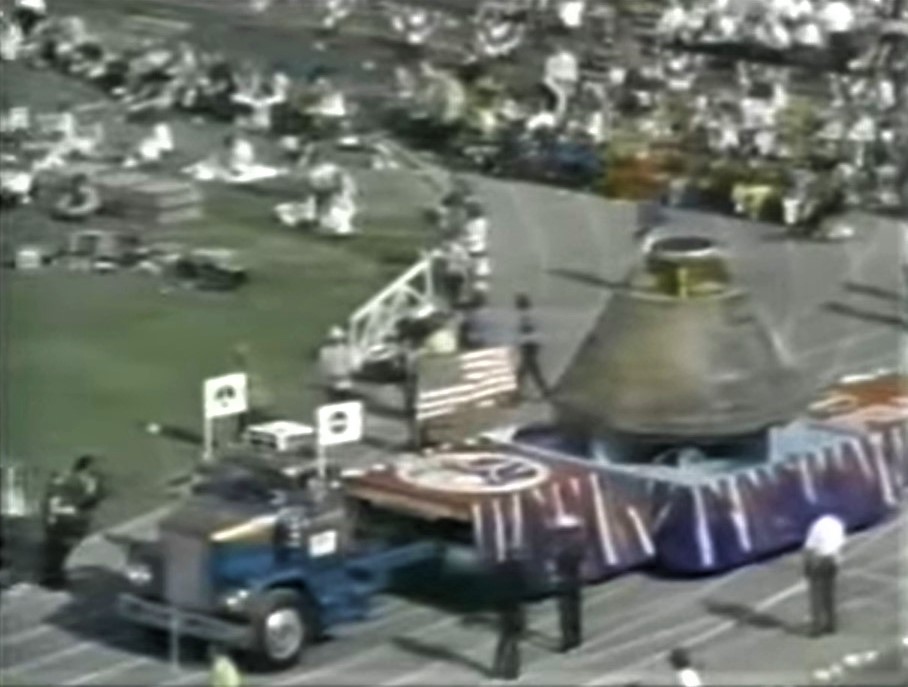

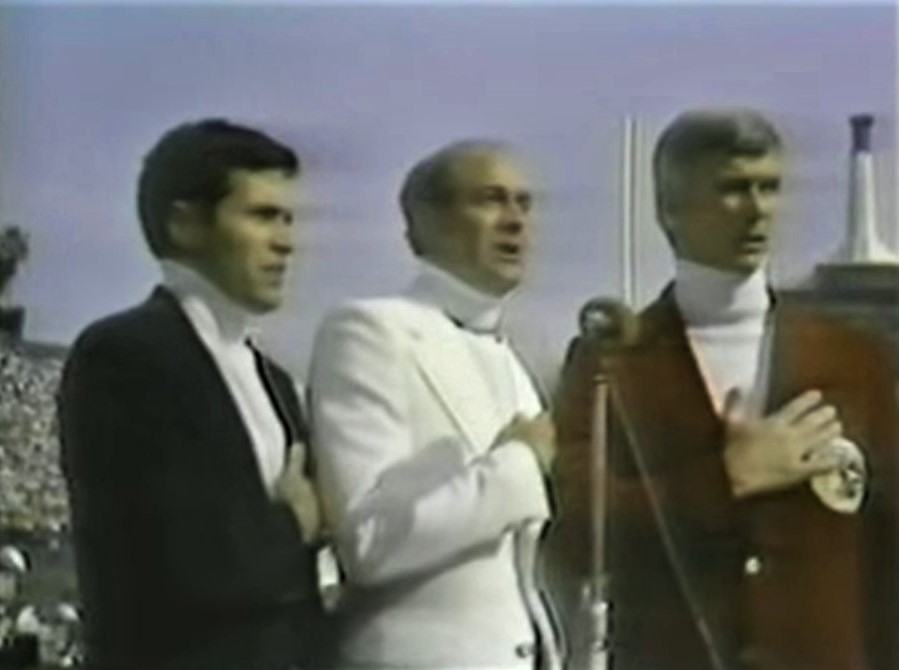
Left: The Apollo 17 Command Module America makes its first public appearance since splashdown at the Super Bowl VII pre-game show at the Los Angeles Coliseum. Middle: Apollo 17 astronauts Harrison H. “Jack” Schmitt, left, Ronald E. Evans, and Eugene A. Cernan enter the Los Angeles Coliseum for the Super Bowl VII pre-game show. Right: Schmitt, left, Evans, and Cernan lead the Pledge of Allegiance during the Super Bowl VII pre-game show. Credits: Images courtesy NBC-TV.
Apollo 17 astronauts Cernan, Evans, and Schmitt began their 11-week United States tour with an appearance at the Jan. 14, 1973, Super Bowl VII football game in the Los Angeles Coliseum. During the pregame show, the Apollo 17 Command Module (CM) America made its first public appearance since splashdown as it entered the stadium on a flatbed truck. Cernan, Evans, and Schmitt followed the spacecraft into the stadium in a convertible, wearing red, white, and blue blazers, respectively. After the playing of the national anthem, they led the crowd in reciting the Pledge of Allegiance. The next day, Cernan, Evans, and Schmitt visited NASA’s Jet Propulsion Laboratory (JPL) in nearby Pasadena to thank employees there for their support of the lunar landing effort.
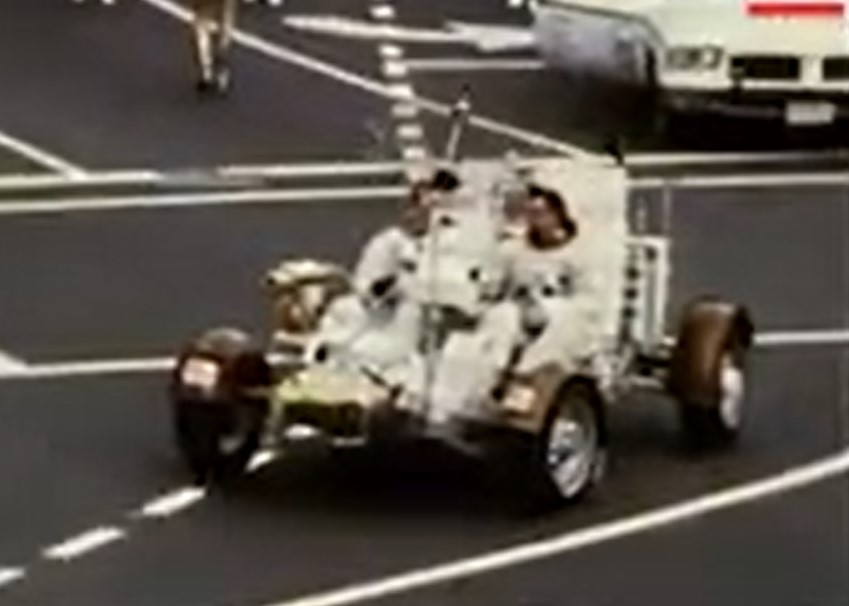
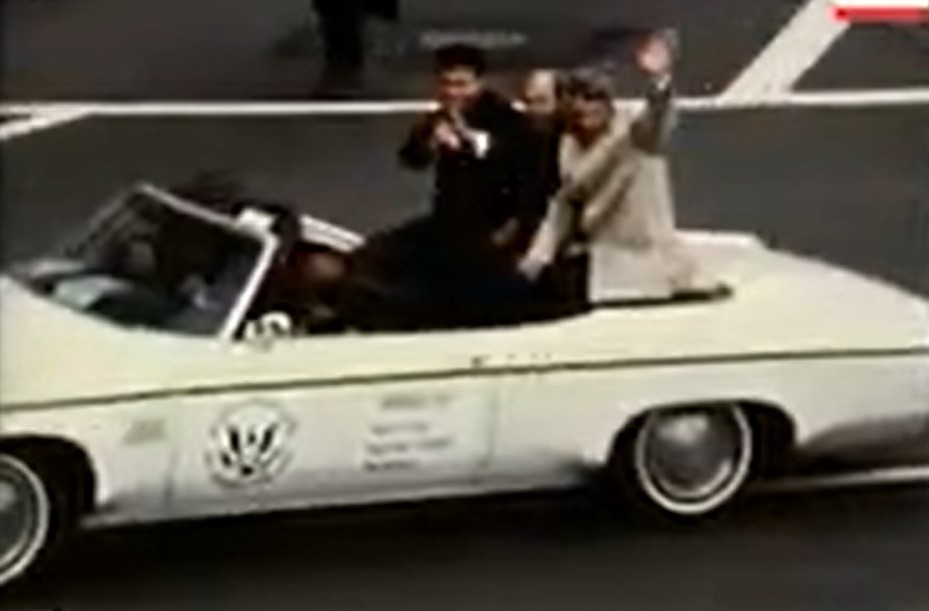 Left: The ground-based trainer of the Lunar Roving Vehicle takes part in President Richard M. Nixon’s second inauguration parade. Right: Apollo 17 astronauts Harrison H. “Jack” Schmitt, left, Ronald E. Evans, and Eugene A. Cernan ride in a convertible during the presidential inauguration parade. Credits: Images courtesy AP Archive.
Left: The ground-based trainer of the Lunar Roving Vehicle takes part in President Richard M. Nixon’s second inauguration parade. Right: Apollo 17 astronauts Harrison H. “Jack” Schmitt, left, Ronald E. Evans, and Eugene A. Cernan ride in a convertible during the presidential inauguration parade. Credits: Images courtesy AP Archive.
After a few days spent at home in Houston, the three astronauts flew to Washington, D.C., to participate in President Richard M. Nixon’s Jan. 20 second inauguration parade. The training version of the Apollo Lunar Roving Vehicle (LRV) preceded the astronauts in the parade and required the replacement of two batteries to negotiate the distance from the Capitol to the White House, due to their limited 30-minute life. Cernan, Evans, and Schmitt watched the battery change from their convertible following the LRV in the procession.
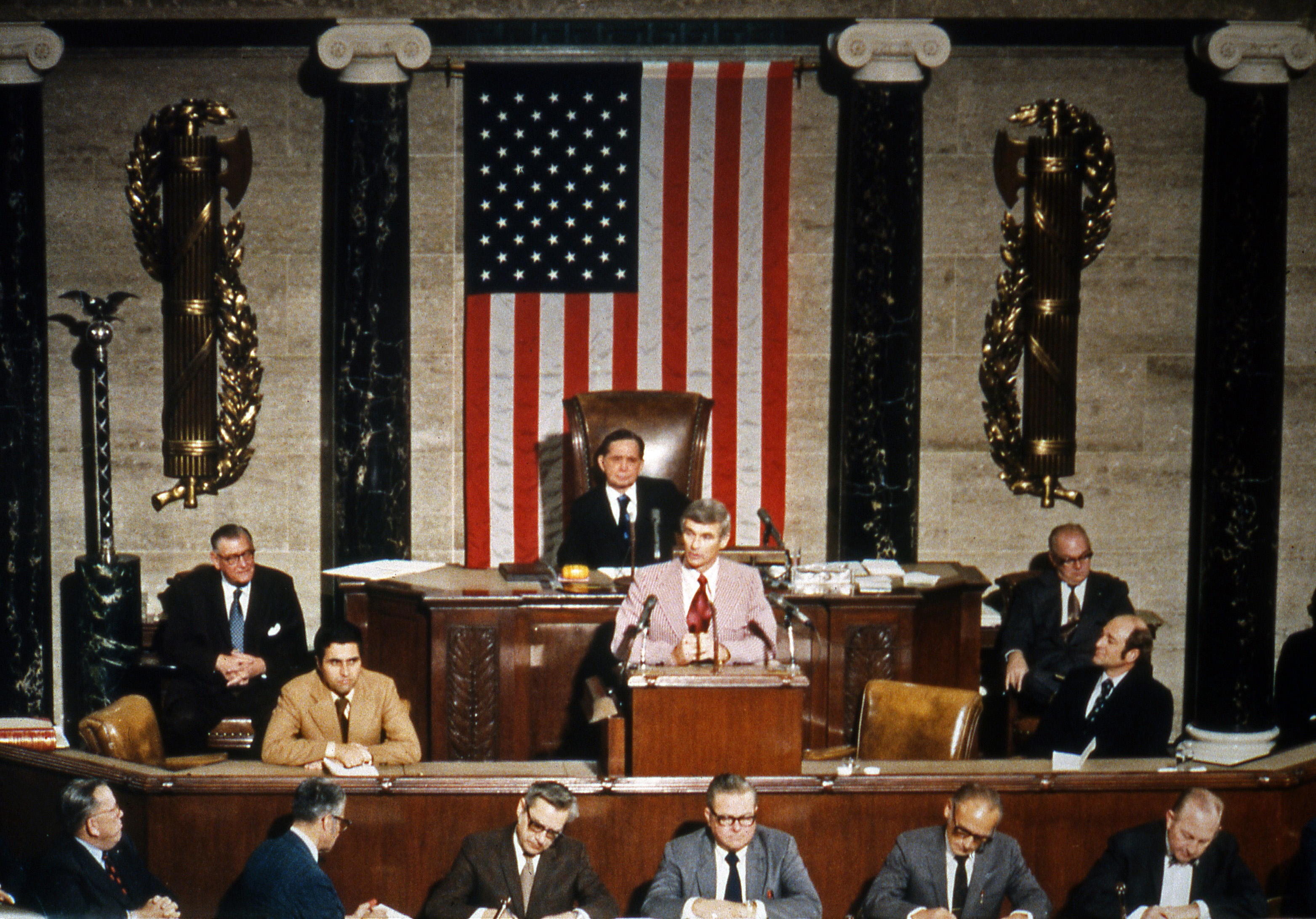
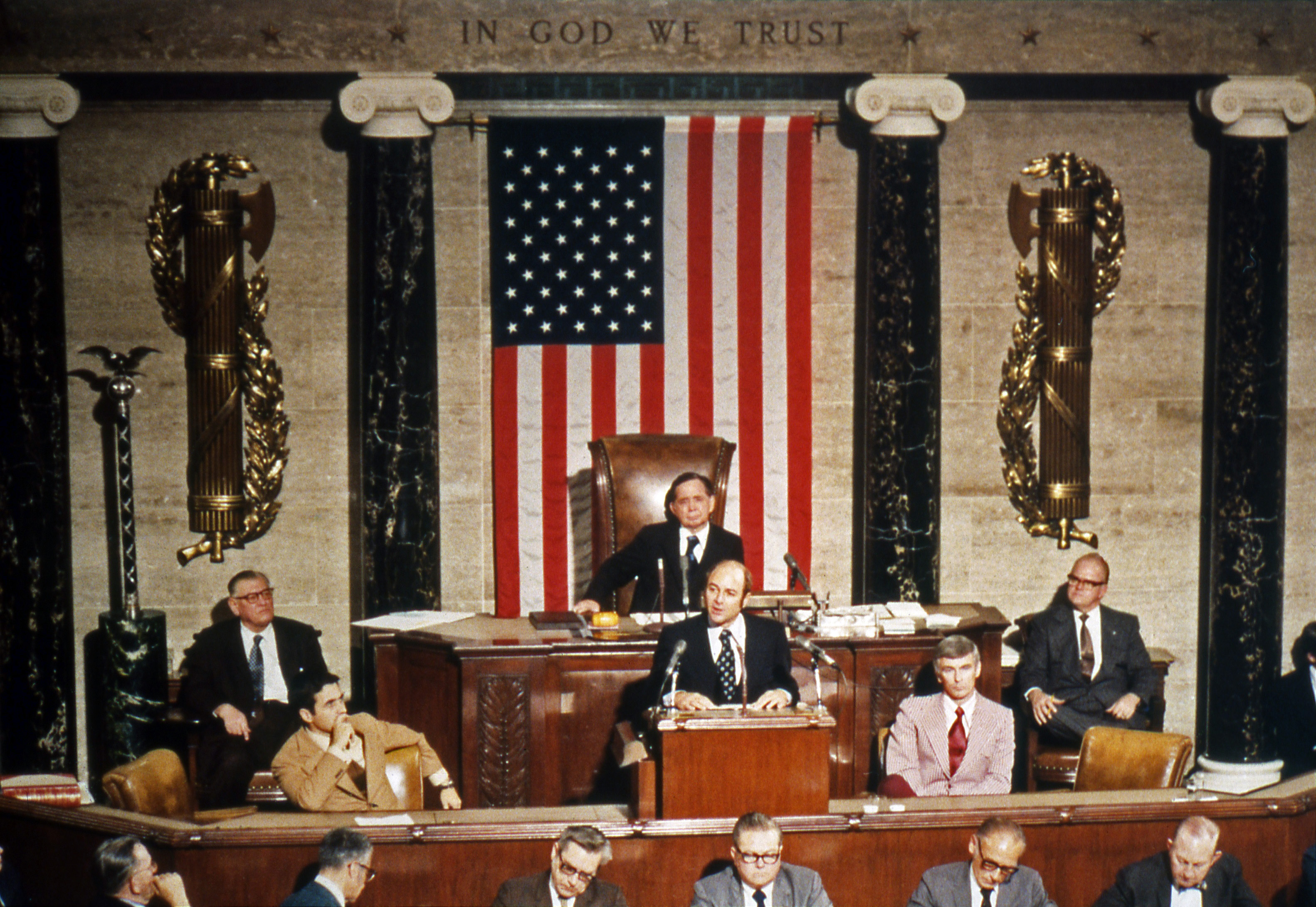
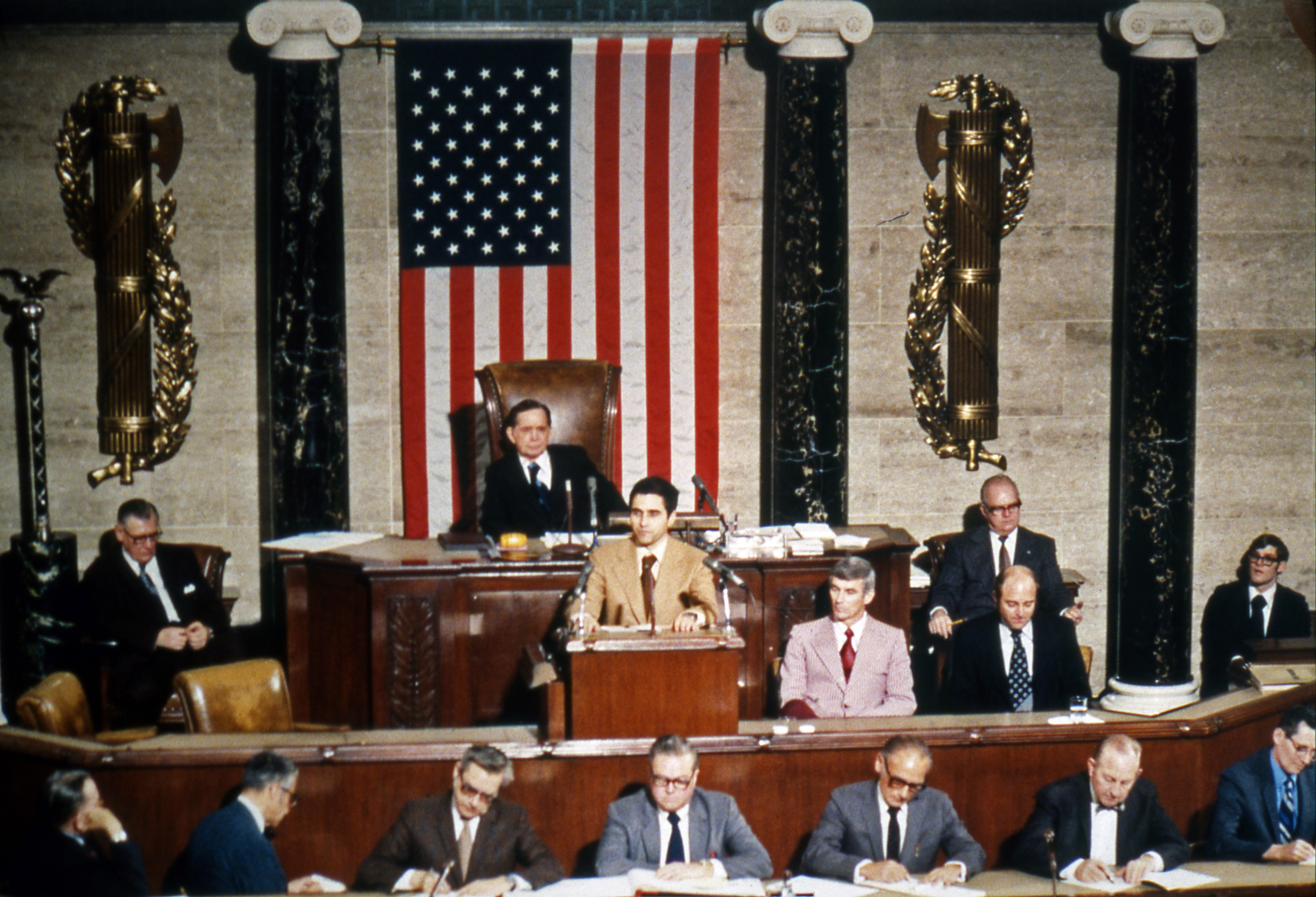
Apollo 17 astronauts Eugene A. Cernan, left, Ronald E. Evans, and Harrison H. “Jack” Schmitt speak to the U.S. House of Representatives.

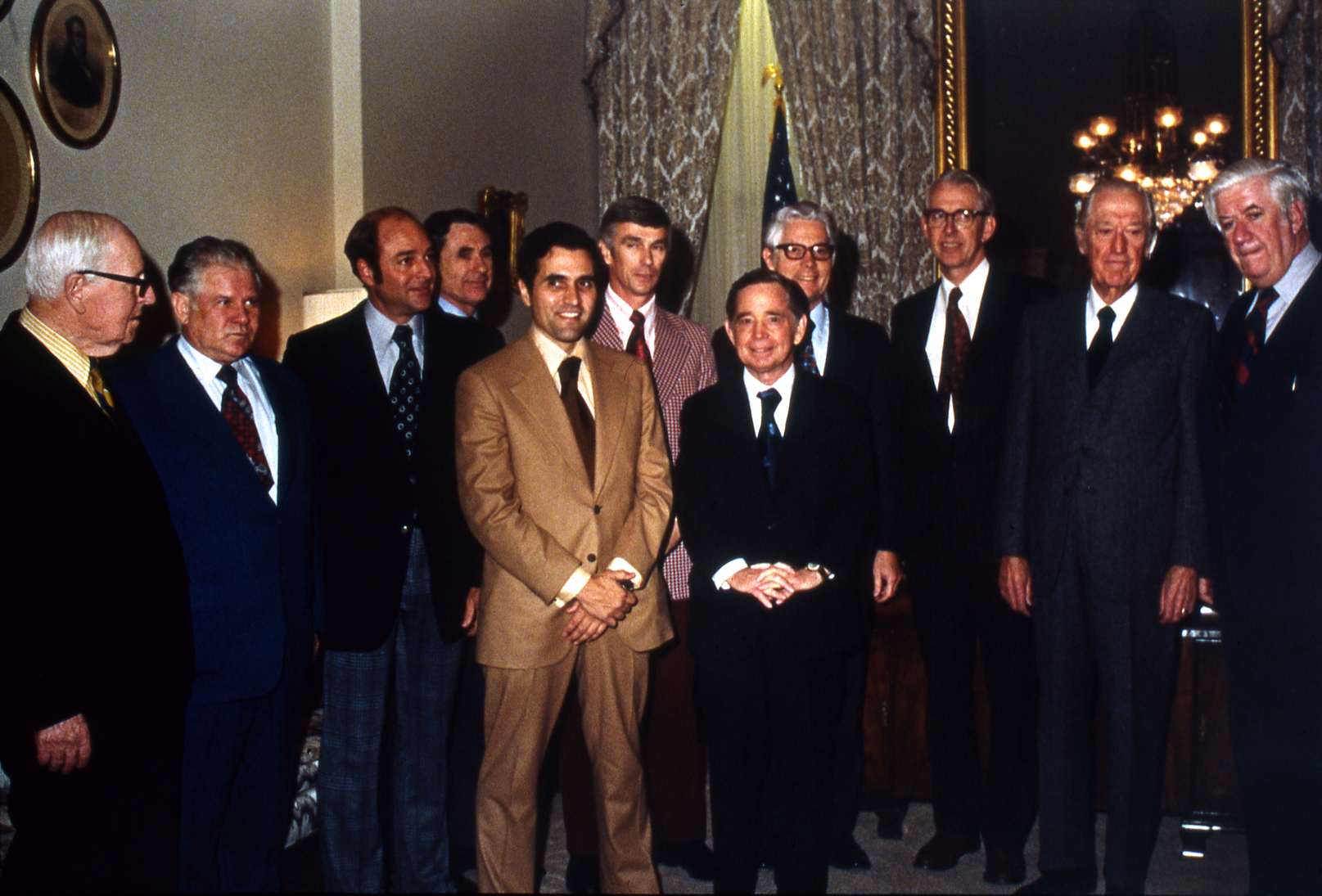
Left: The assembled members of the House of Representatives give a standing ovation to Apollo 17 astronauts Harrison H. “Jack” Schmitt, left, Ronald E. Evans, and Eugene A. Cernan. Right: The Apollo 17 astronauts pose with Congressional leadership.
On Jan.22, the House of Representatives welcomed Cernan, Evans, and Schmitt to the U.S. Capitol – the Senate was not in session. Cernan told the House that Apollo 11 astronaut Neil A. Armstrong’s placement of the first U.S. flag on the moon in 1969 had been “a symbol of the courage and the dedication and the effort and self-sacrifice of 200 million people in this country who made that effort possible.” With one step by Armstrong, “we are able to gain something that we had never really been able to grab hold of in my lifetime.” Evans said his stay in the CM had made him realize that earth, like his spacecraft, had limited consumable resources and “somehow the human survival requirement means that we have got to conserve these resources and man must learn to adapt to his environment.” Schmitt said that, in obtaining knowledge through the Apollo program, man had evolved into entering the universe. “Although the nature of that evolution was technological, I believe it will be marked a thousand years from now as a single unique event in human history” appearing “more distinctly even than history’s record of our use of atomic energy.”
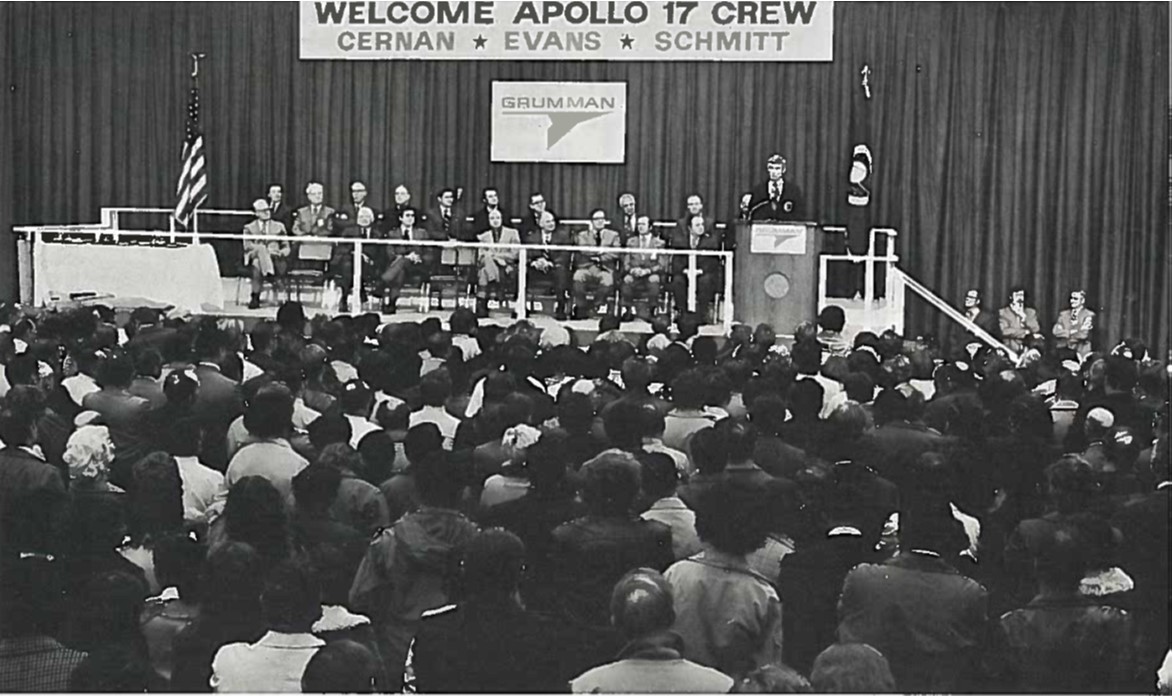
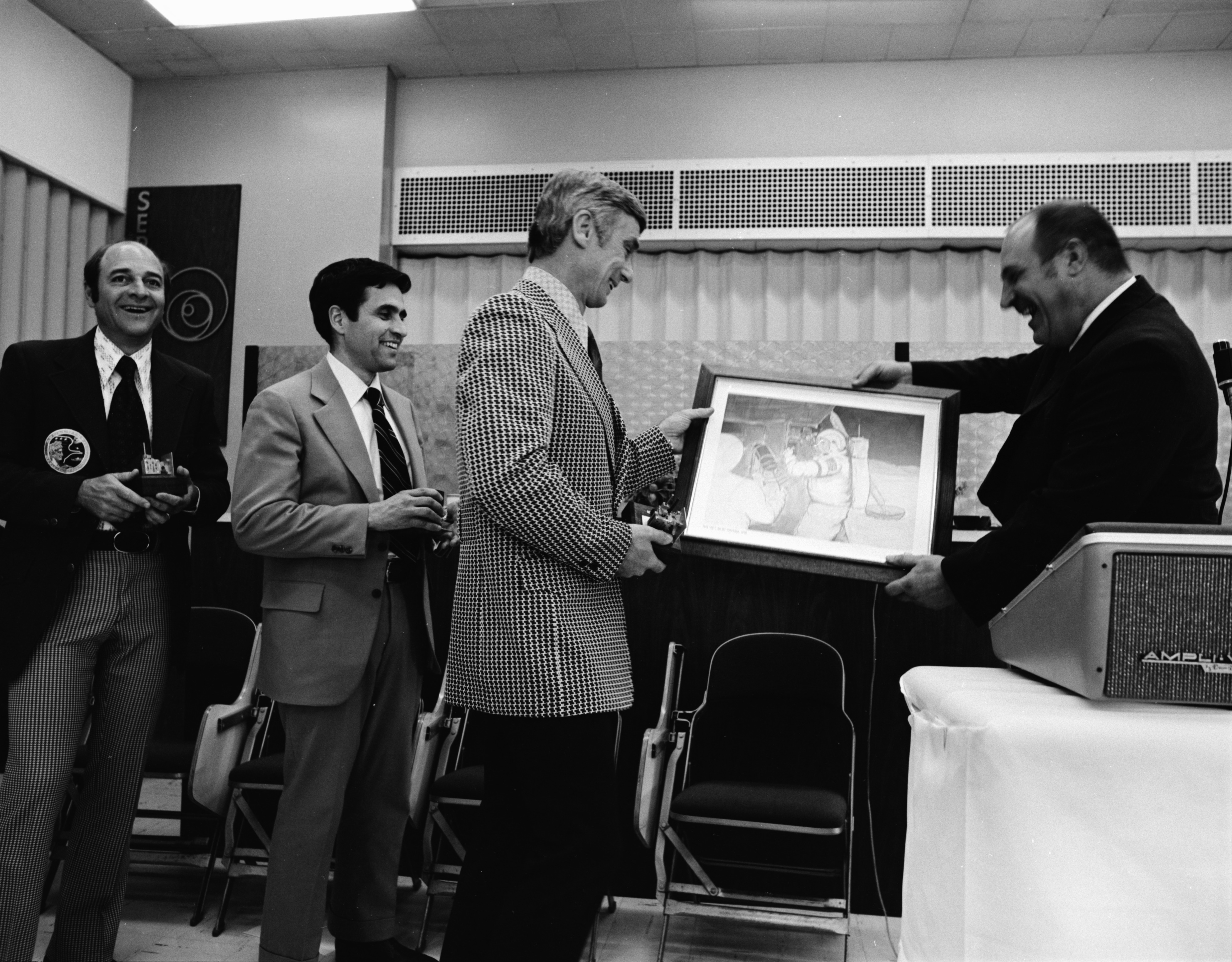
Left: Apollo 17 commander Eugene A. Cernan speaks to an assembled audience at the Grumman Aircraft Corporation’s Bethpage, New York, facility, where their Lunar Module Challenger was manufactured, while Harrison H. “Jack” Schmitt and Ronald E. Evans await their turn at the podium. Right: Evans, left, Schmitt, and Cernan at the Bendix Corporation plant in Ann Arbor, Michigan, manufacturer of the Apollo Lunar Surface Experiments Package.
From Washington, D.C., Cernan, Evans, and Schmitt traveled to Bethpage, New York, where on Jan. 23 they visited the Grumman Aircraft Corporation, manufacturer of their Lunar Module (LM) Challenger. The astronauts held a press conference, then addressed an assembled crowd of about 1,500 employees, thanking them for manufacturing such a fine spacecraft. Three days later found them in Ann Arbor, Michigan, at the Bendix Corporation, manufacturer of the Apollo Lunar Surface Experiments Package (ALSEP), the suite of instruments most Apollo crews deployed on the Moon’s surface.
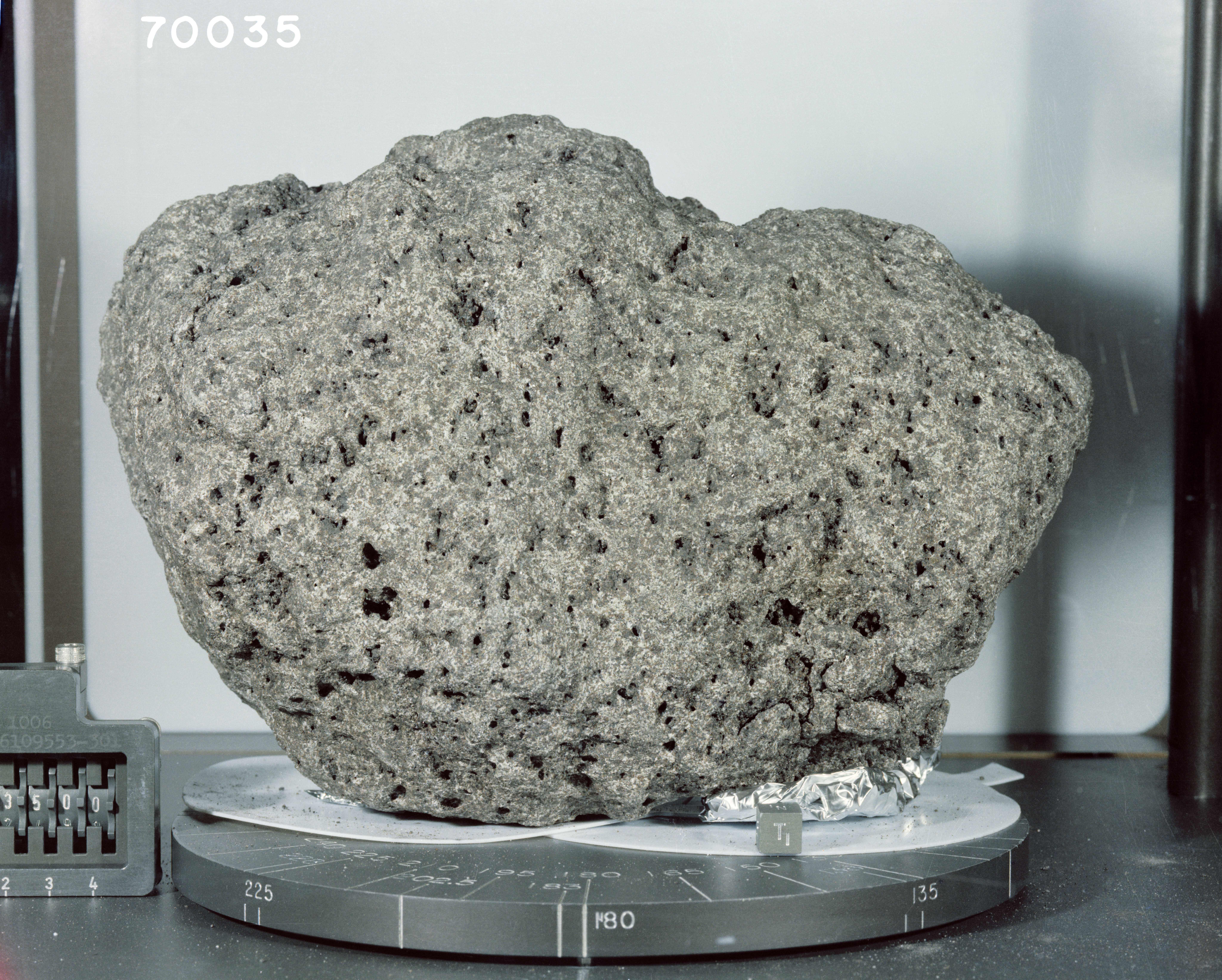
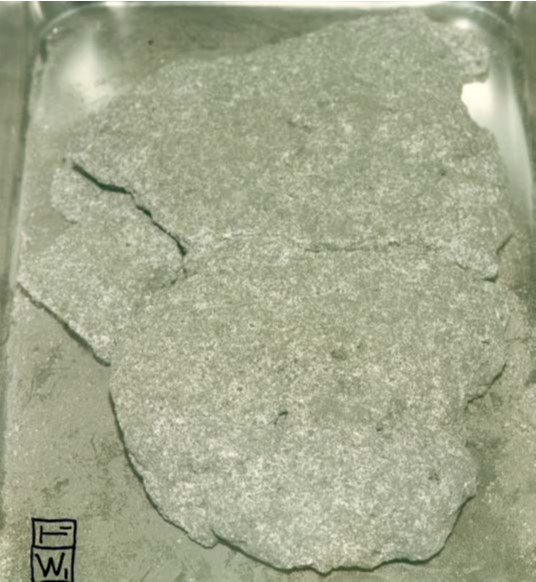
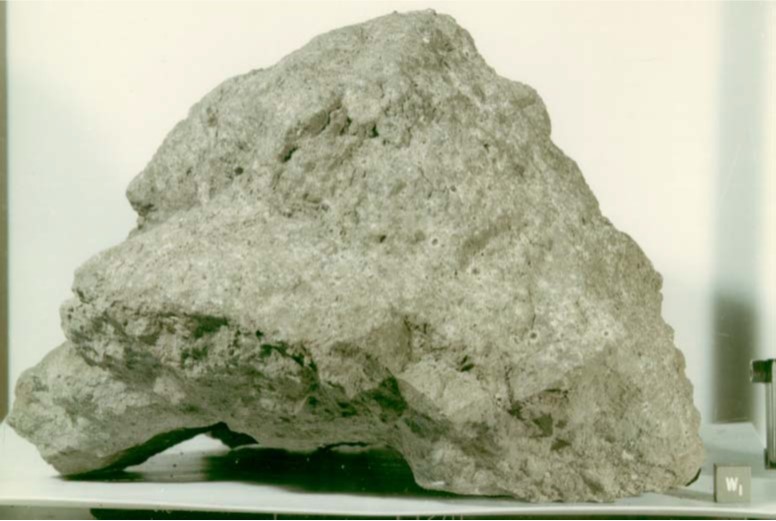
The three Apollo 17 Moon rocks from which the first group of scientists received samples – 70035, left, 75055, and 76055.
On Jan. 31, the Manned Spacecraft Center, now NASA’s Johnson Space Center (JSC) in Houston, named 10 investigators to receive the first Apollo 17 lunar samples. Five U.S. and five foreign scientists received allocations that included tiny rock chips and polished thin sections cut from three large rocks. Rocks 70035 and 75055 were dark gray basalts typical of material underlying the Taurus-Littrow valley, while rock 76055 was a lighter-colored recrystallized breccia that might have been part of the mountainside at one time. NASA made these early sample allocations with the stipulation that scientists could present preliminary results at the 4th Annual Lunar Science Conference held at JSC March 5-8. They initially determined the ages of the samples and analyzed their trace element and mineralogical content. In March, NASA provided three grams of Apollo 17 samples, along with three grams from Apollo 16, to Soviet representatives who in turn gave NASA samples from their Luna 16 and 20 robotic sample return missions.
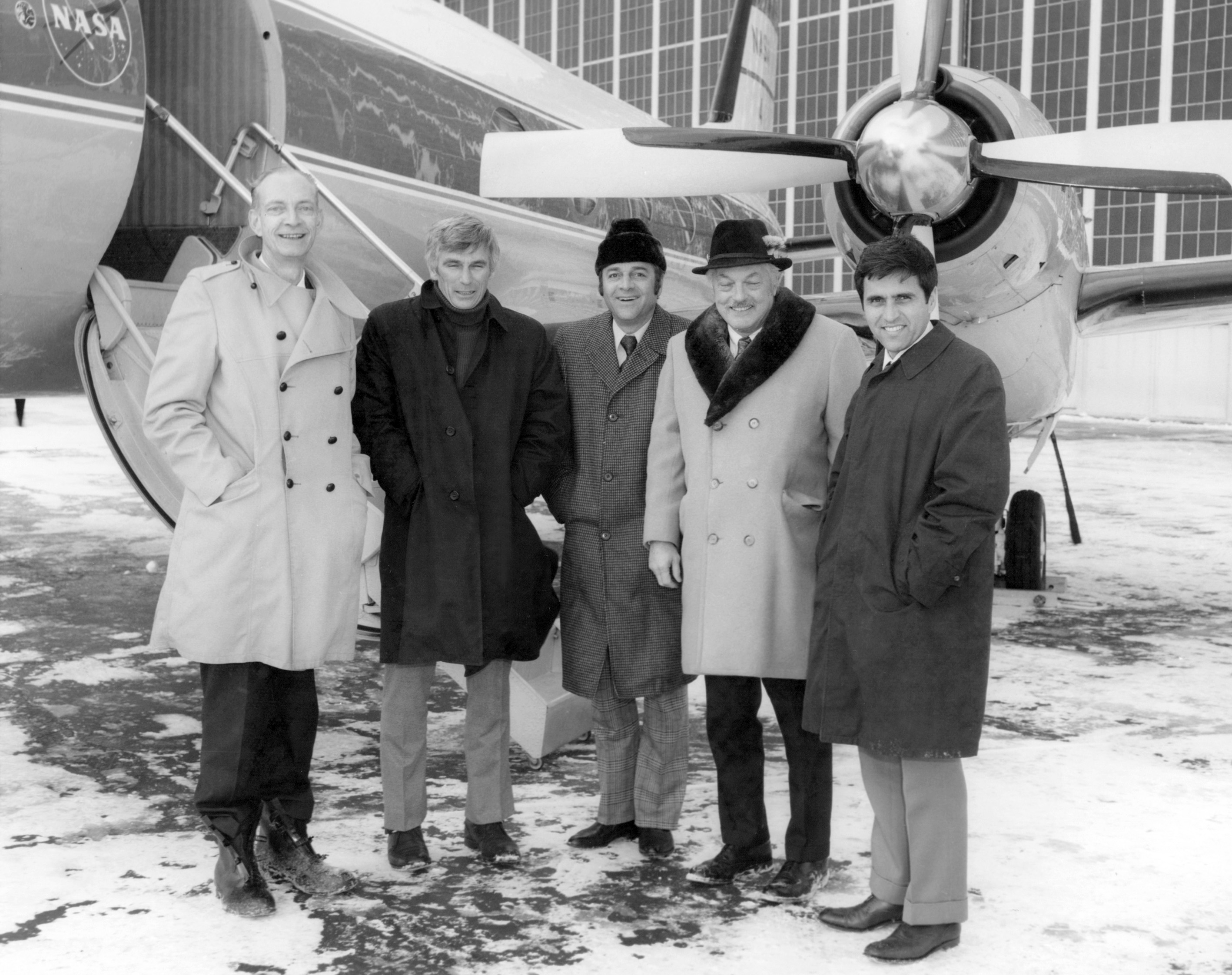
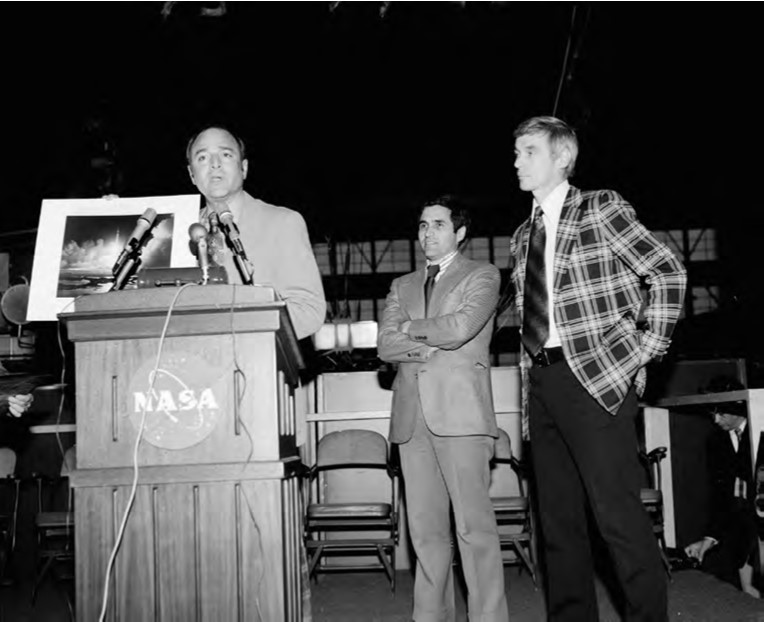
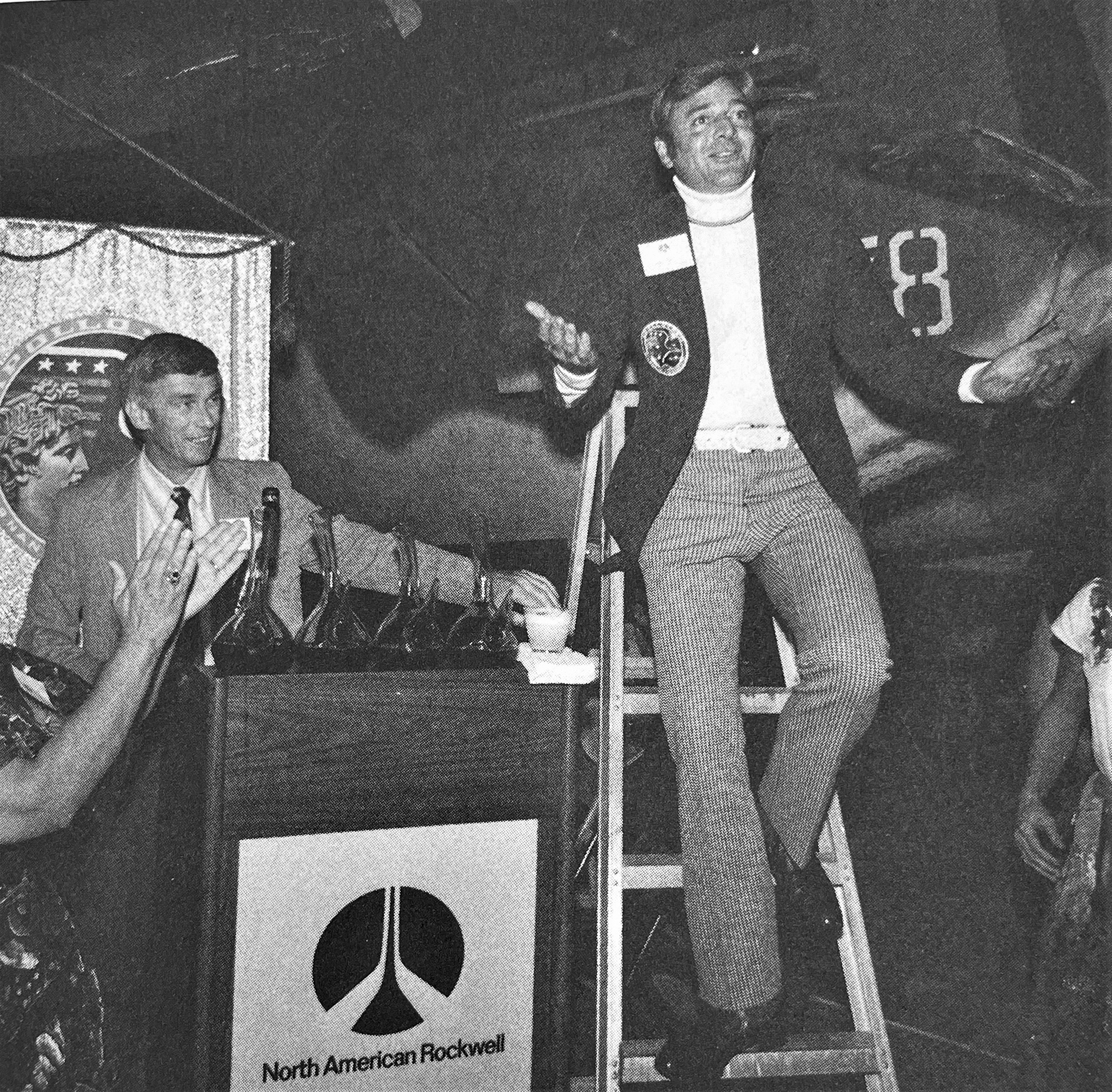
Left: Apollo 17 astronauts Eugene A. Cernan, second from left, Ronald E. Evans, and Harrison H. “Jack” Schmitt, right, greeted upon their arrival at the Lewis Research Center, now NASA’s Glenn Research Center in Cleveland, Ohio. Middle: Evans, left, Schmitt, and Cernan thank employees at NASA’s Langley Research Center in Hampton, Virginia. Right: Cernan, left, and Evans, address the audience at the North American Rockwell plant in Downey, California.
Cernan, Evans, and Schmitt visited NASA field centers during their nationwide tour. As noted above, they visited JPL, Grumman, and Bendix in January. On Feb. 16, during a four-day tour that also included stops in Atlanta, Arkansas, Nebraska, and Chicago, they visited the Lewis Research Center, now NASA’s Glenn Research Center in Cleveland, Ohio, and Plum Brook Station, now NASA’s Neil A. Armstrong Test Facility, in nearby Sandusky. They also spoke at two nearby schools and held a press conference.
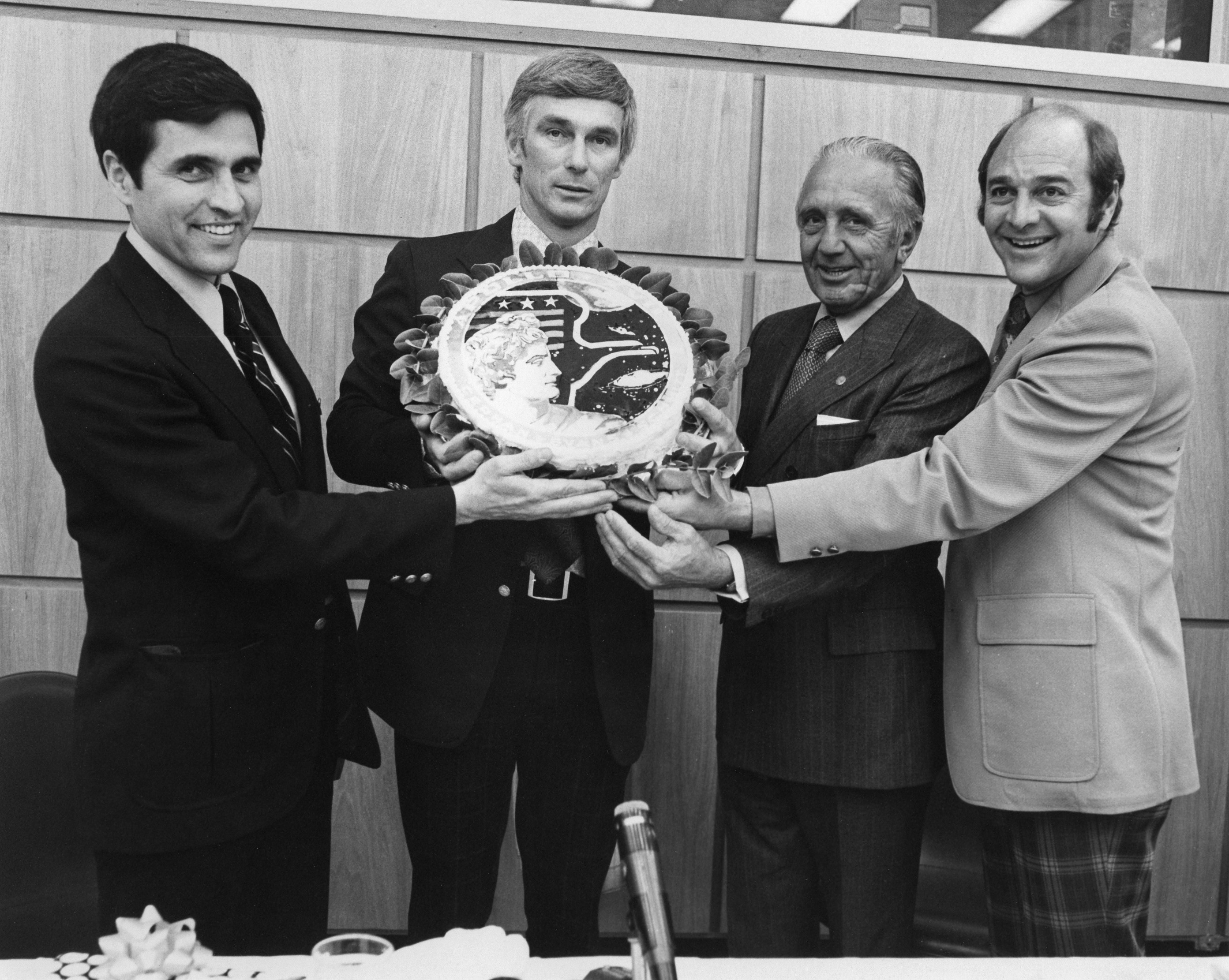
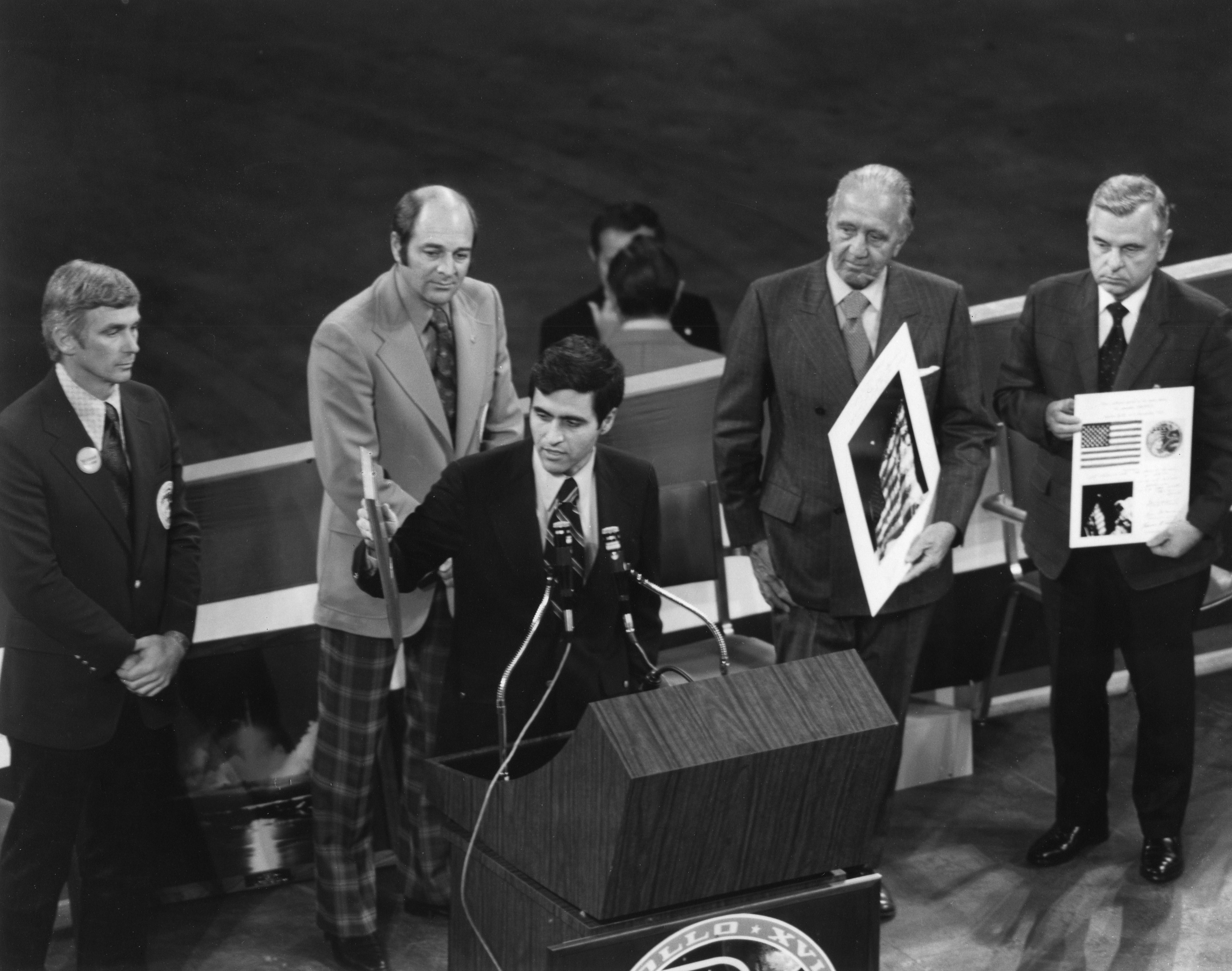
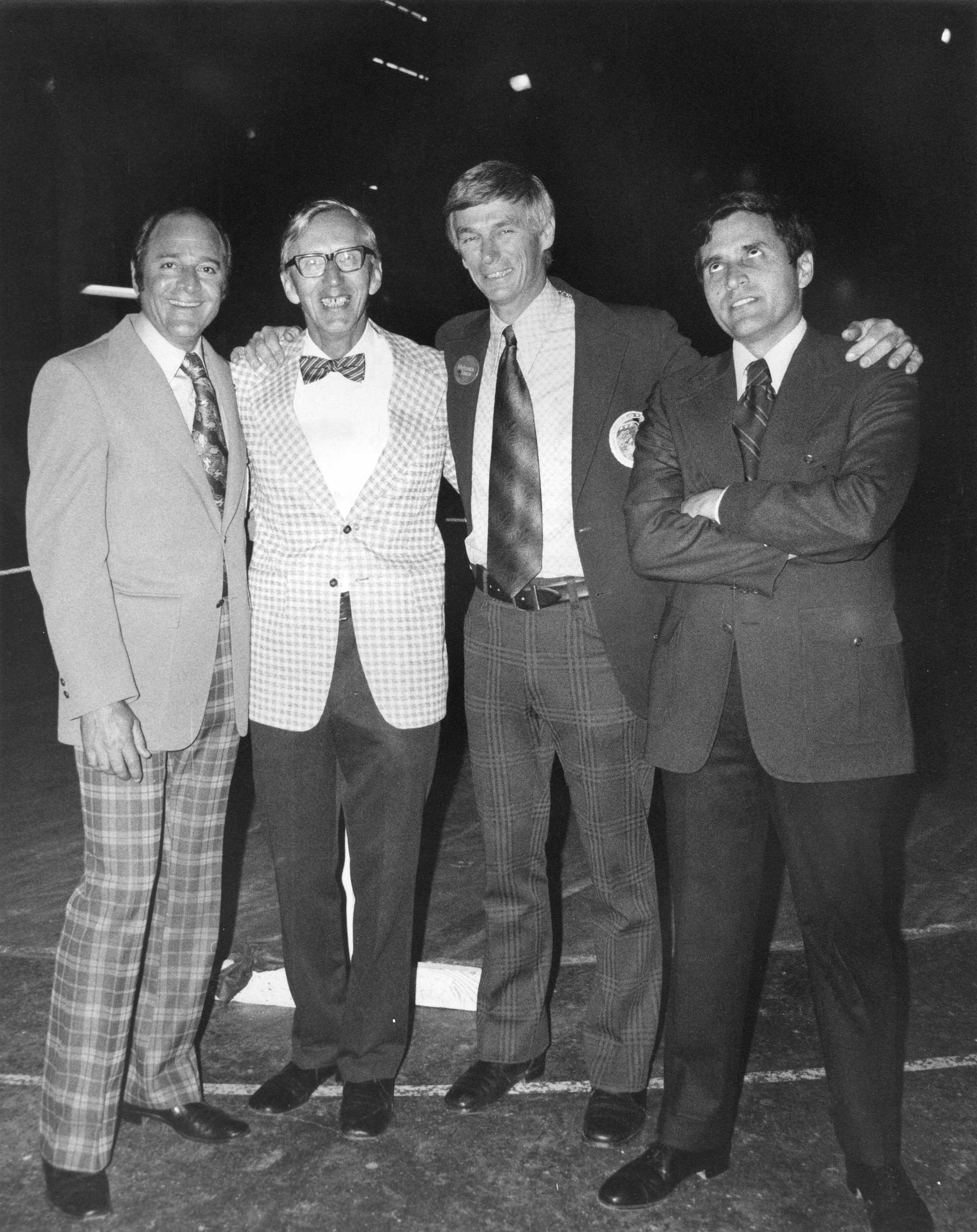
Left: Apollo 17 astronauts Harrison H. “Jack” Schmitt, left, Eugene A. Cernan, and Ronald E. Evans, right, show off a cake decorated with their mission patch at a luncheon at NASA’s Kennedy Space Center (KSC) in Florida, with KSC Director Kurt H. Debus, second from right. Middle: During a reception inside KSC’s Vehicle Assembly Building, Cernan, left, Evans, and Schmitt receive photographs of their launch. Right: The Apollo 17 astronauts pose with White Room closeout team leader Guenter Wendt.
On Feb. 20, Cernan, Evans, and Schmitt visited NASA’s Kennedy Space Center (KSC) in Florida to thank employees for their efforts in making human exploration of the Moon possible. Schmitt hopefully predicted that humans would explore Mars in the not too distant future. “The reason it is possible to talk this way and not be accused of talking science fiction is because there’s no longer science fiction. It’s now only science prediction.” They returned to KSC on April 4 to present employees with awards for their contributions to the success of their mission. On Feb. 27, they stopped at NASA’s Langley Research Center in Hampton, Virginia, where Cernan repeated his message that “we stood on the shoulders of giants as we shot for the stars,” referring to audience members for their foundational contributions to the Apollo program, including development of the Lunar Orbit Rendezvous plan that NASA adopted for the Moon landings.
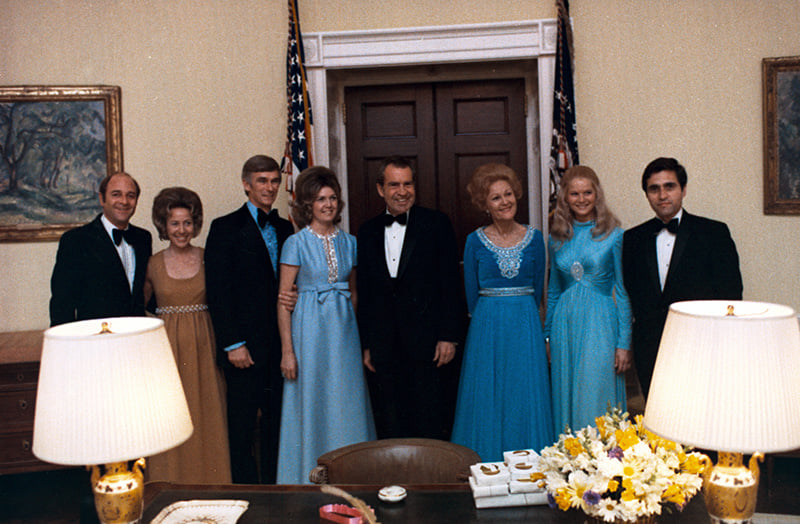
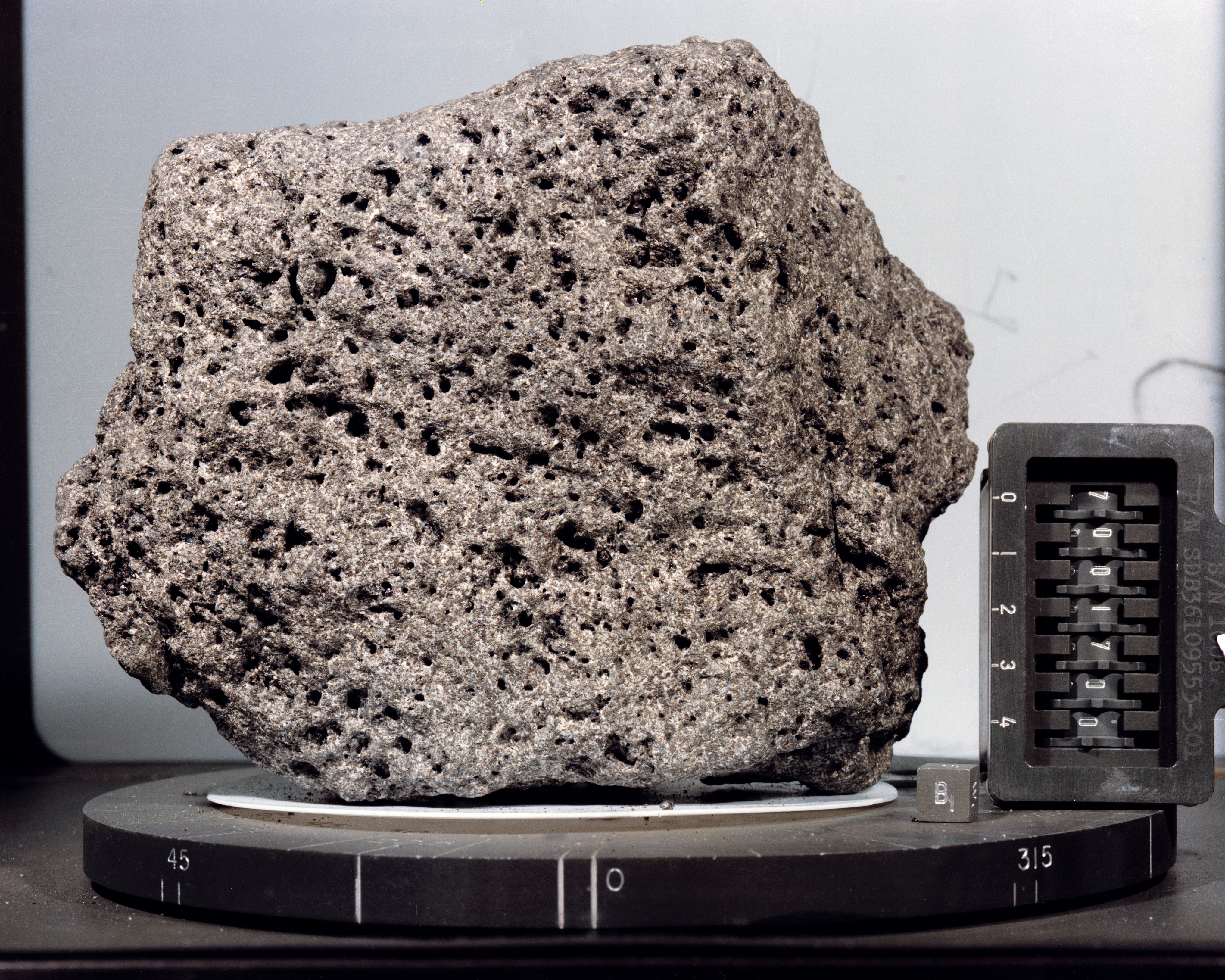
Left: At the White House reception for the Apollo 17 astronauts, Ronald E. and Jan Evans, left, Eugene A. and Barbara Cernan, President Richard M. Nixon and First Lady Pat Nixon, and Adair Atwell and Harrison H. “Jack” Schmitt. Right: The Goodwill Rock, Apollo 17 sample 70017, the source of fragments provided to U.S. states and foreign heads of state.
After privately hosting the Apollo 17 astronauts and their families at Camp David, President Richard M. Nixon and First Lady Pat Nixon entertained them at the White House on Mar. 3. Members of Congress and the Secretaries of Labor, Transportation, and Commerce also attended the event, with singer Sammy Davis, Jr., providing the entertainment. Later that month, President Nixon directed that pieces of the last rock collected by Cernan and Schmitt, officially sample number 70017 but informally known as the Goodwill Rock, be distributed to all 50 states and U.S. territories and to 135 foreign heads of state. By the time they finished their tour around the country, Cernan, Evans, and Schmitt had met with 12 state governors and addressed eight state legislatures. And then they took their tour to the world stage.
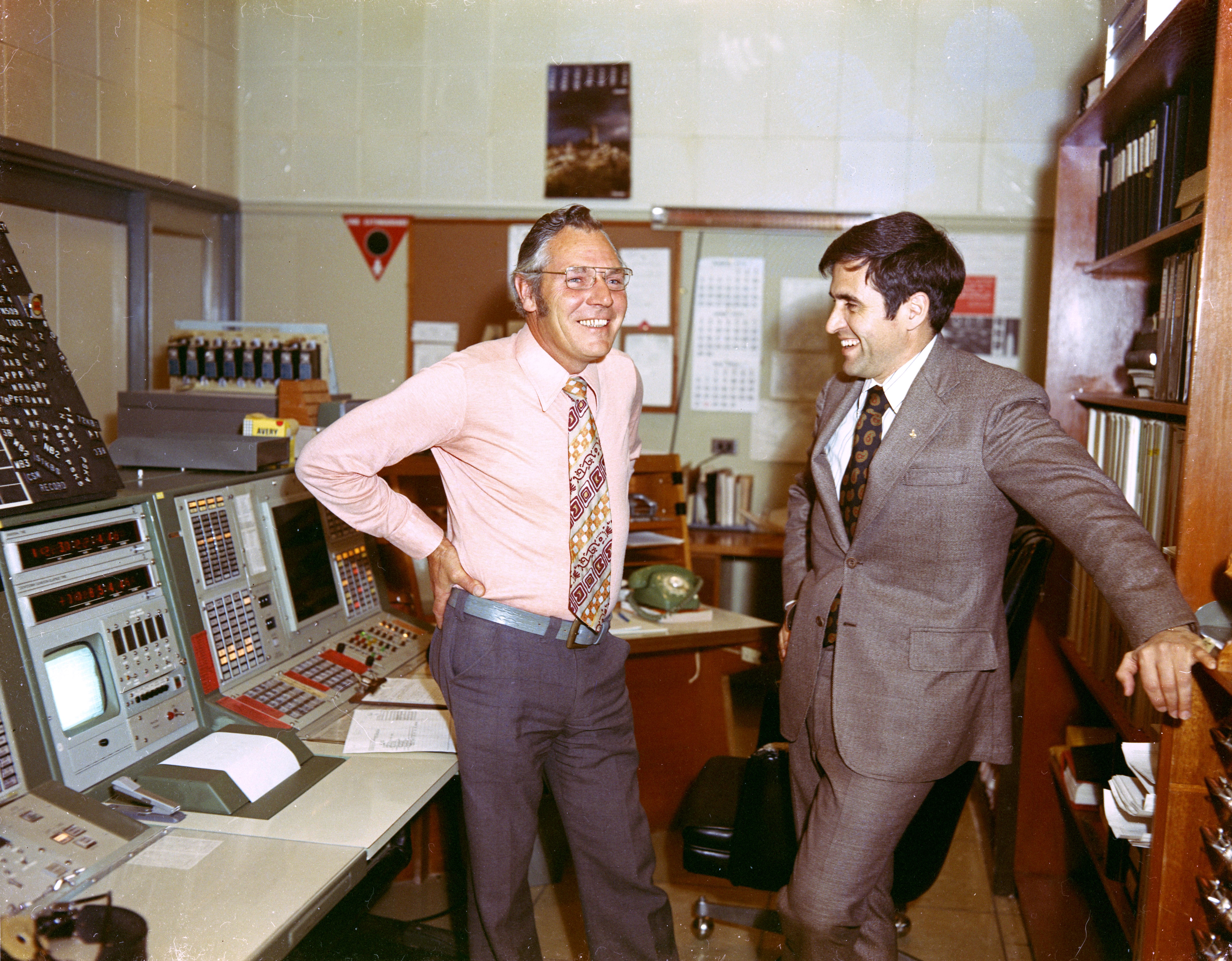
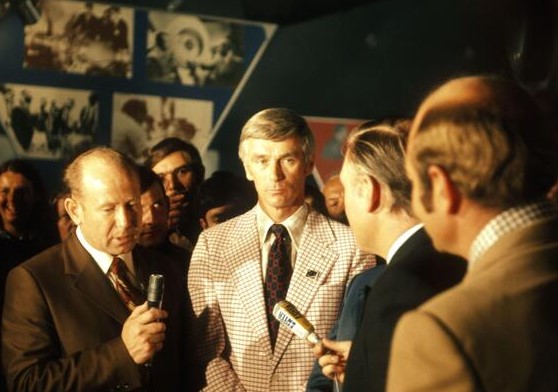
Left: Apollo 17 astronaut Harrison H. “Jack” Schmitt, right, chats with telemetry supervisor Laurie Turner during his May 1973 visit to the Honeysuckle Creek tracking station in Australia. Credit: Image courtesy Hamish Lindsay. Right: Soviet cosmonaut Aleksei A. Leonov and Apollo 17 astronaut Eugene A. Cernan answer reporters’ questions at the Paris Air Show.
In early May, Schmitt traveled to Australia to visit the Honeysuckle Creek tracking station and thank the employees there for their support during mission critical times such as the lunar surface excursions. On May 30, at the 30th Paris Air Show, Cernan, Evans, and Schmitt, along with American commander of the Apollo-Soyuz Test Project (ASTP) Thomas P. Stafford, met with cosmonauts Aleksei A. Leonov and Valeri N. Kubasov, the prime Soviet ASTP crew, Anatoli V. Filipchenko, a member of the backup ASTP crew, and Aleksey S. Yeliseyev, Soviet director of ASTP operations, at the U.S.-U.S.S.R. pavilion, an exhibit that included a life-size replica of the docked Apollo and Soyuz spacecraft. From Paris, Cernan, Evans, and Schmitt flew to Las Palmas in the Canary Islands, the staging site for their international goodwill tour.
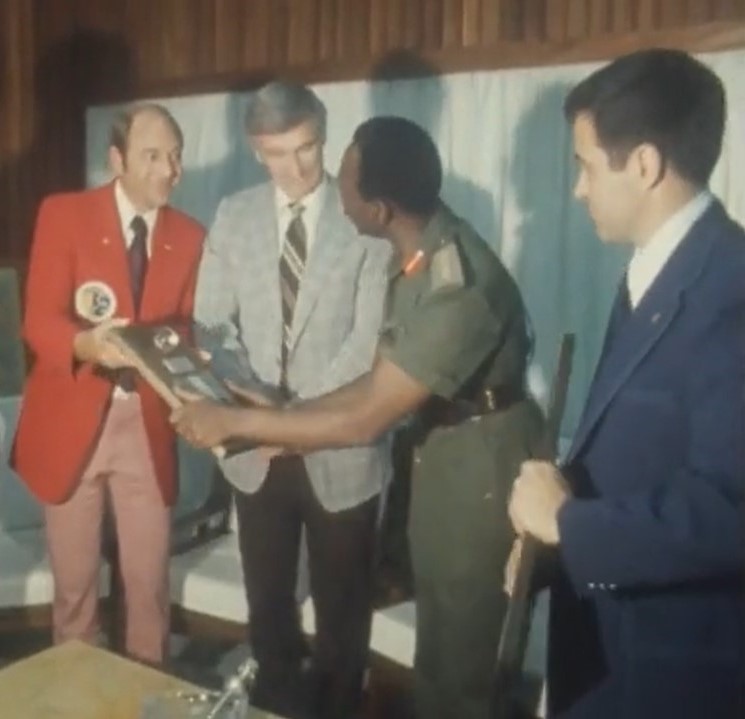
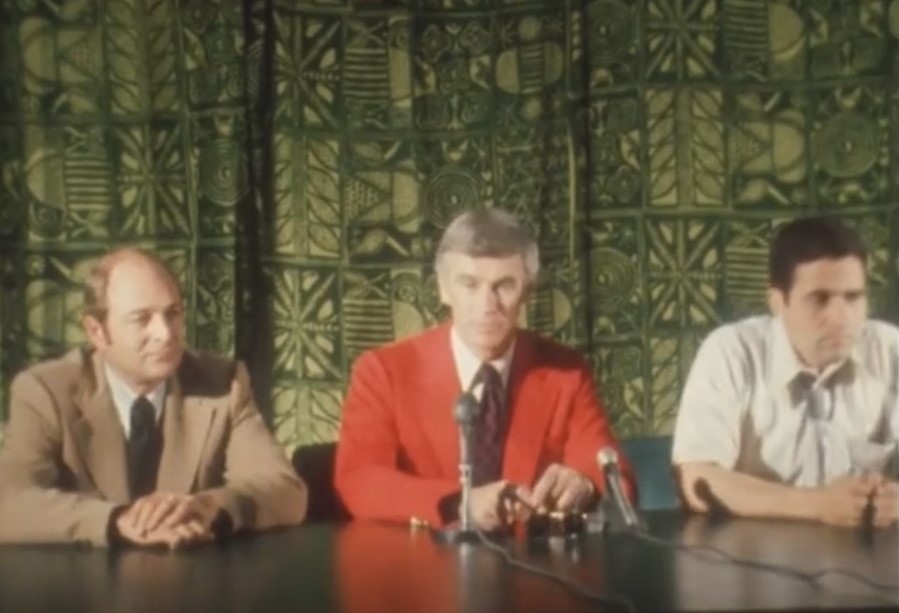
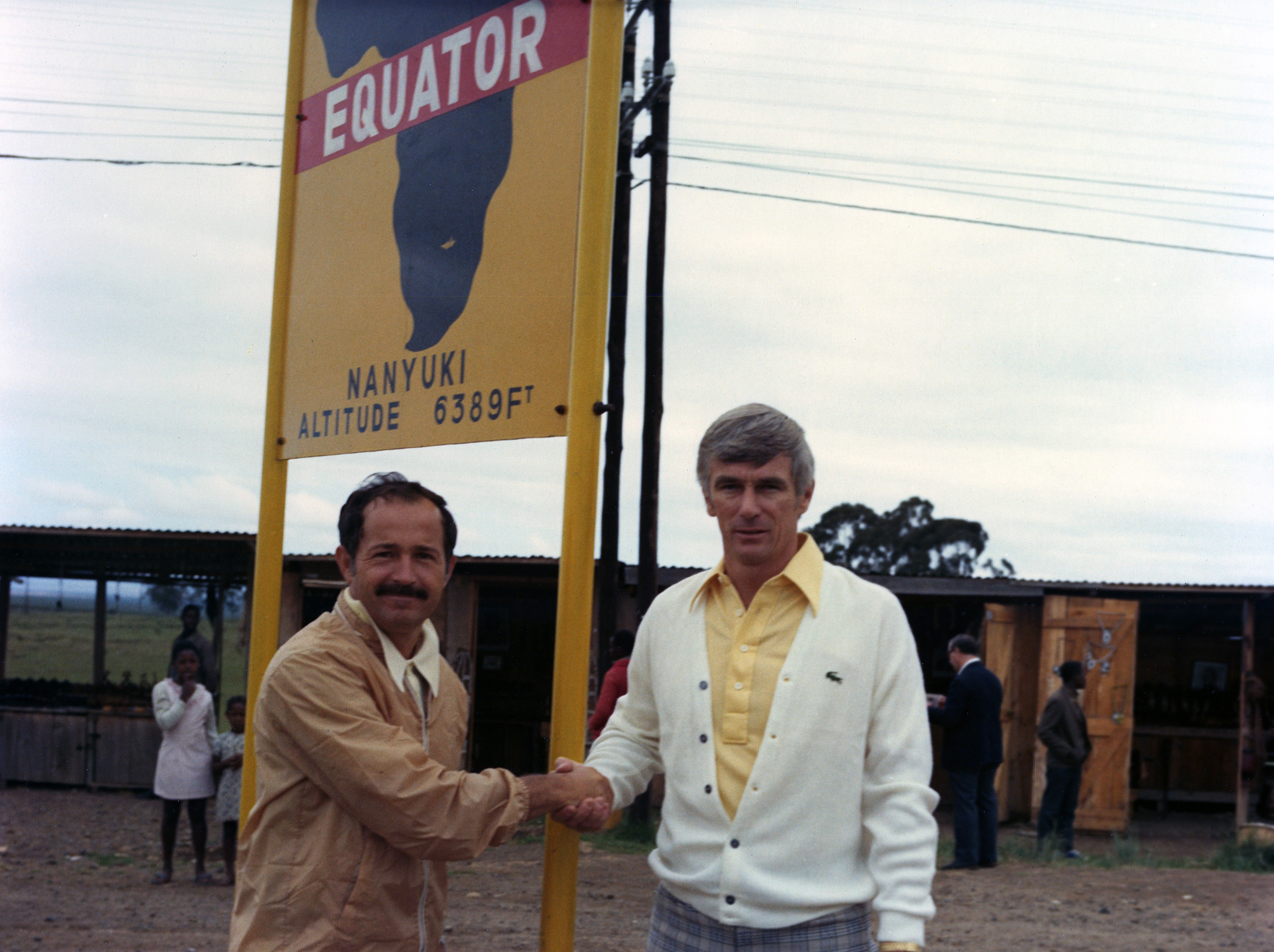
Left: Apollo 17 astronauts Ronald E. Evans, left, Eugene A. Cernan, and Harrison H. “Jack” Schmitt present Nigerian Head of State General Yakabu Gowon, second from right, with a sample of the Goodwill Rock they collected on the Moon. Middle: Evans, left, Cernan, and Schmitt hold a press conference in Lagos, Nigeria. Credits: Images courtesy British Pathé. Right: Cernan, right, stands on the equator in Nanyuki, Kenya.
On May 18, President Nixon had announced plans for the Apollo 17 astronauts and their wives – except for Schmitt who was a bachelor – to undertake a goodwill tour “in the spirit of Apollo” to 11 nations, many not previously visited by U.S. astronauts. The President made the Vice President’s jet available for the tour. In addition to meeting with world leaders, the astronauts spoke at universities about the science results from Apollo to engage the next generation of explorers. Although a flight surgeon typically accompanied astronauts on these goodwill tours, Cernan insisted on having Dolores B. “Dee” O’Hara, longtime nurse to the astronaut corps, made a member of the entourage instead. From their staging point in the Canary Islands, the goodwill tour made its first stop in Dakar, Senegal, on June 2. The astronauts’ wives and O’Hara stayed in the American ambassador’s residence while Cernan, Evans, and Schmitt flew to the interior of the country to give talks about their mission. At their next stop in Niamey, Niger, President Hamani Diori treated the visitors to a state dinner. The next day, the astronauts gave a round of speeches while Madame Diori took the women sightseeing, at one point encountering a herd of giraffes. After a one-day stop in Abidjan, Côte d’Ivoire (Ivory Coast), the entourage arrived in Lagos, Nigeria, on June 10 for a four-day visit. The astronauts met and exchanged ideas with local scientists and lectured to science students at three universities. During their meeting with Nigerian Head of State General Yakubu Gowon, they presented him with a sample from the Goodwill Rock, a model of the Lunar Module, and a plaque bearing the flag of Nigeria that had traveled with them to the Moon. From Nigeria, the group traveled to Cameroon on June 13, with sightseeing trips over the dense jungle, and then to Kenya, where they took the obligatory photographs at the equator.
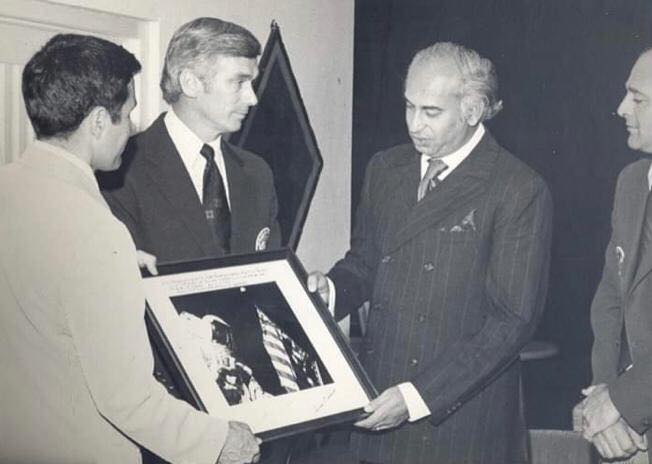
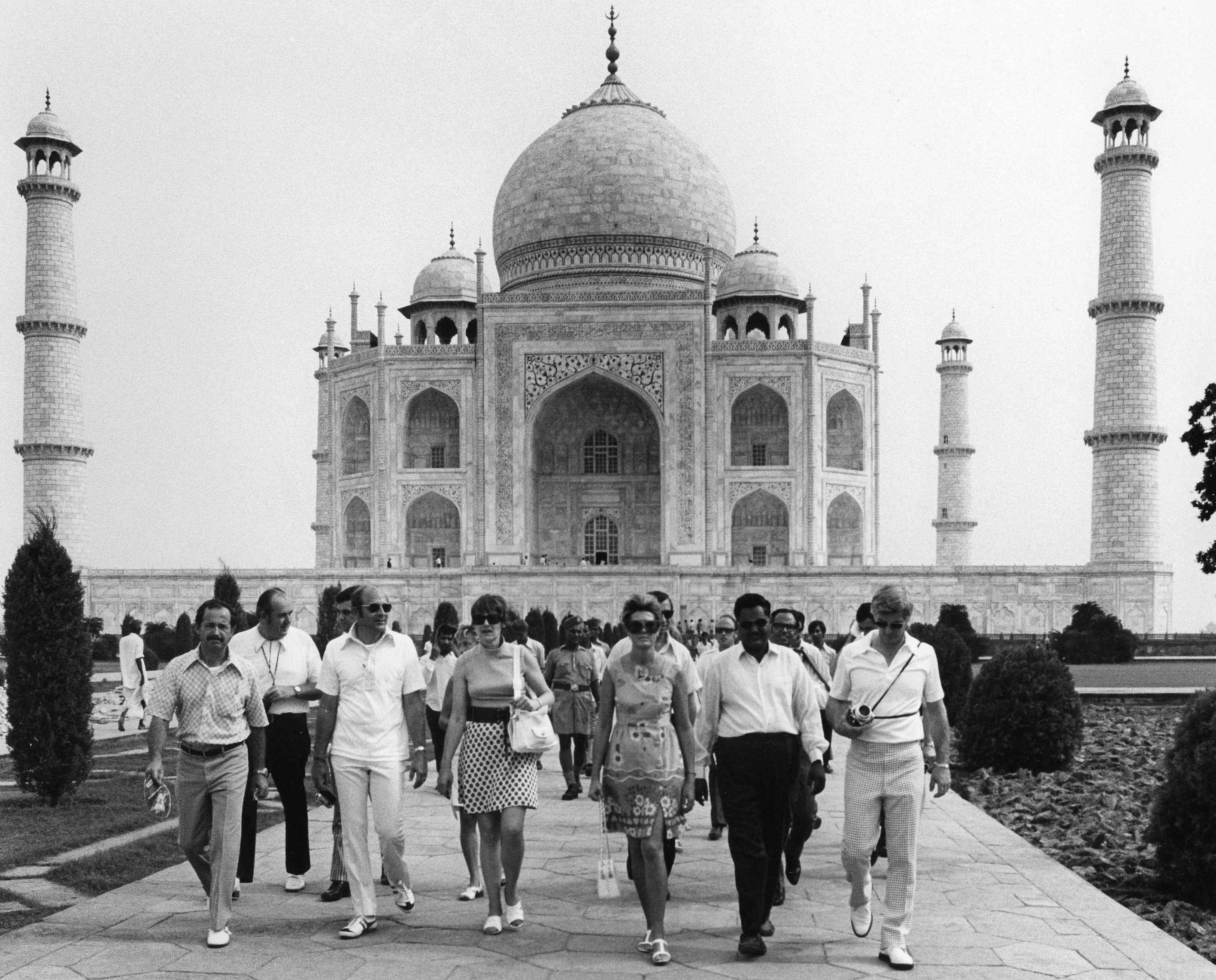
Left: Apollo 17 astronauts Harrison H. “Jack” Schmitt, left, Eugene A. Cernan, and Ronald E. Evans, right, present a photograph from their mission to Pakistani President Zulfiqar Ali Bhutto, second from right. Credit: Image courtesy The Karachi Walla. Right: Apollo 17 astronauts tour the Taj Mahal in Agra, India.
From Kenya, Cernan, Evans, Schmitt, and their entourage traveled to Karachi, Pakistan, arriving on June 17 for a three-day visit. Among the events, they gave talks at Karachi University to hundreds of students and visited the tomb of Mohammed Ali Jinnah, Pakistan’s founder and first president. They met with Pakistani President Zulfikar Ali Bhutto, presenting him with photographs from their mission, a sample from the Goodwill Rock, and a Pakistani flag they flew to the Moon. From Karachi, they traveled to India, visiting the Taj Mahal, and had the opportunity to ride camels in addition to touring the famous landmark. Then they flew on to Singapore for a brief visit. On June 25, they arrived in Djakarta, Indonesia, where they presented a sample of the Goodwill Rock to President T.N.J. Suharto and lectured at the Indonesian Institute for Outer Space and enjoyed a side trip to Bali. They spent the July 4 holiday in Manilla, The Philippines, enjoying fireworks with President Ferdinand Marcos. From there, the entourage flew to the islands of Saipan and Tinian in the Northern Marianas, where they met with High Commissioner Edward E. Johnston, and Majuro in the Marshall Islands before returning to Houston with a layover in Honolulu.
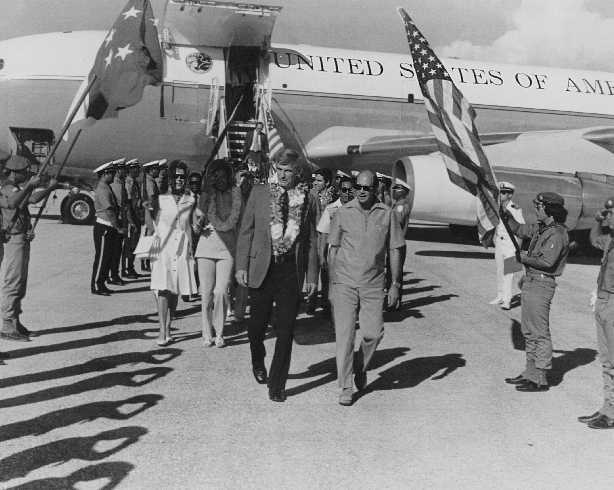
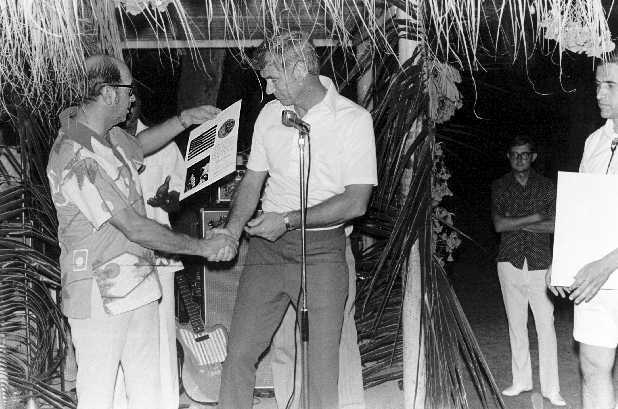
Left: High Commissioner of the Northern Marianas Trust Territory Edward E. Johnston, right, greets the Apollo 17 astronauts and their entourage on Saipan. Right: Eugene A. Cernan, center, presents a plaque with an American flag flown to the Moon to High Commissioner Johnston, left. Credit: Images courtesy University of Hawaii.
On Dec. 11, 1973, the first anniversary of their Moon landing, Cernan and Schmitt commemorated the event in JSC’s Mission Control Center (MCC). They presented an American flag that they carried to the Moon and back to Eugene F. Kranz, chief of the Flight Control Division of JSC’s Flight Operations Directorate, who accepted the flag on behalf of all flight controllers. Cernan and Schmitt had taken the American flag that had flown in MCC since Apollo 11 and planted it in the lunar soil at their Taurus-Littrow landing site. The new flag served as a fitting replacement. Like most previous Apollo crews before them, Cernan and Schmitt deployed an ALSEP suite of science instruments at their landing site. Most of the instruments at the five sites operated well for years, but when funding for the technical and science support ran out, NASA shut down the instruments on Sept. 30, 1977. Scientists had sent more than 153,000 commands to the instruments and received more than one trillion bits of science data back. Although the experiments were turned off, the transmitters continued to send carrier signals that various institutions, including the Jet Propulsion Laboratory, used for geodetic and astrometric studies, and spacecraft navigation. In addition, scientists still use laser retroreflectors left on the surface by Apollo 11, 14, and 15, along with two more on Soviet Lunokhod rovers, to precisely measure the Earth-Moon distance.
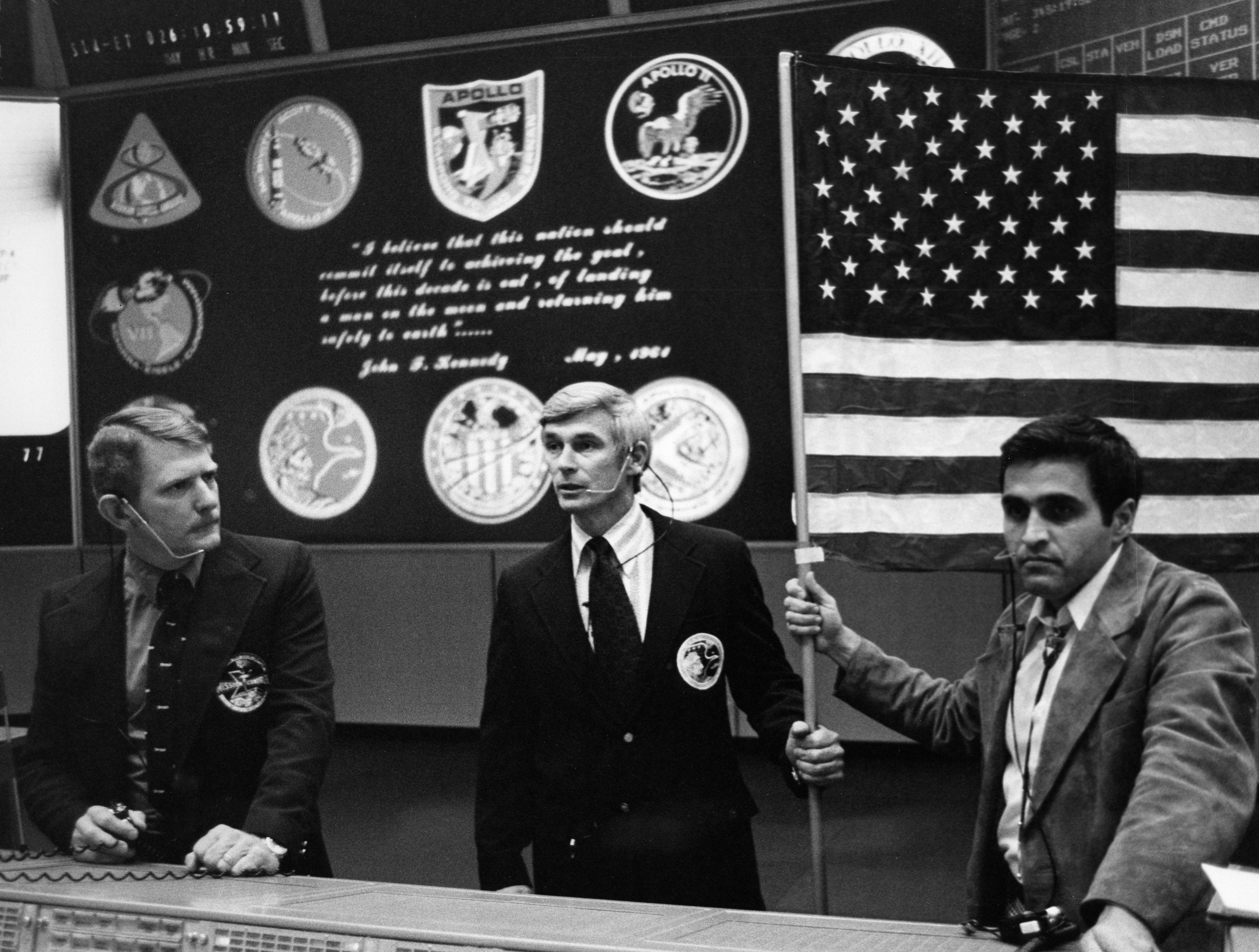
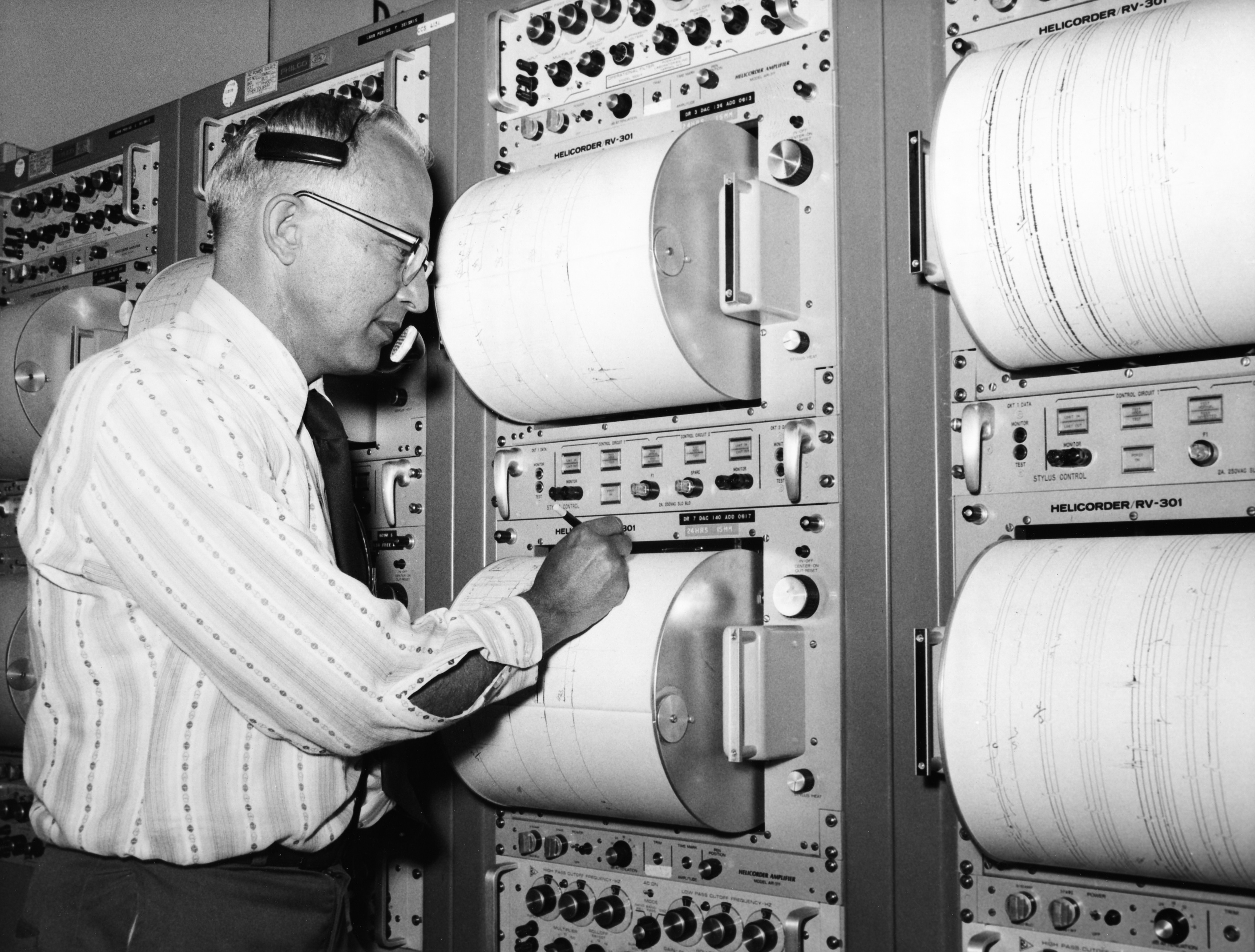
Left: Flight Director Eugene F. Kranz, left, watches as Apollo 17 astronauts present the American flag they took to the Moon to the Mission Control Center at NASA’s Johnson Space Center in Houston on the first anniversary of their lunar landing. Right: A scientist examines tracings from seismometers left on the Moon by Apollo astronauts, part of the Apollo Lunar Surface Experiment Packages at five landing sites.
Following splashdown, the Apollo 17 Command Module America was transported to its manufacturer, the North American Rockwell facility in Downey, California, arriving there on Jan. 2, 1973. After its brief public appearance at the Super Bowl VII pregame show on Jan. 14, NASA turned ownership of America over to the Smithsonian Institution in 1974, and the spacecraft went on display outside JSC’s main auditorium in March 1974, where it remained until 1992 when workers moved it to nearby Space Center Houston, where it remains on display.
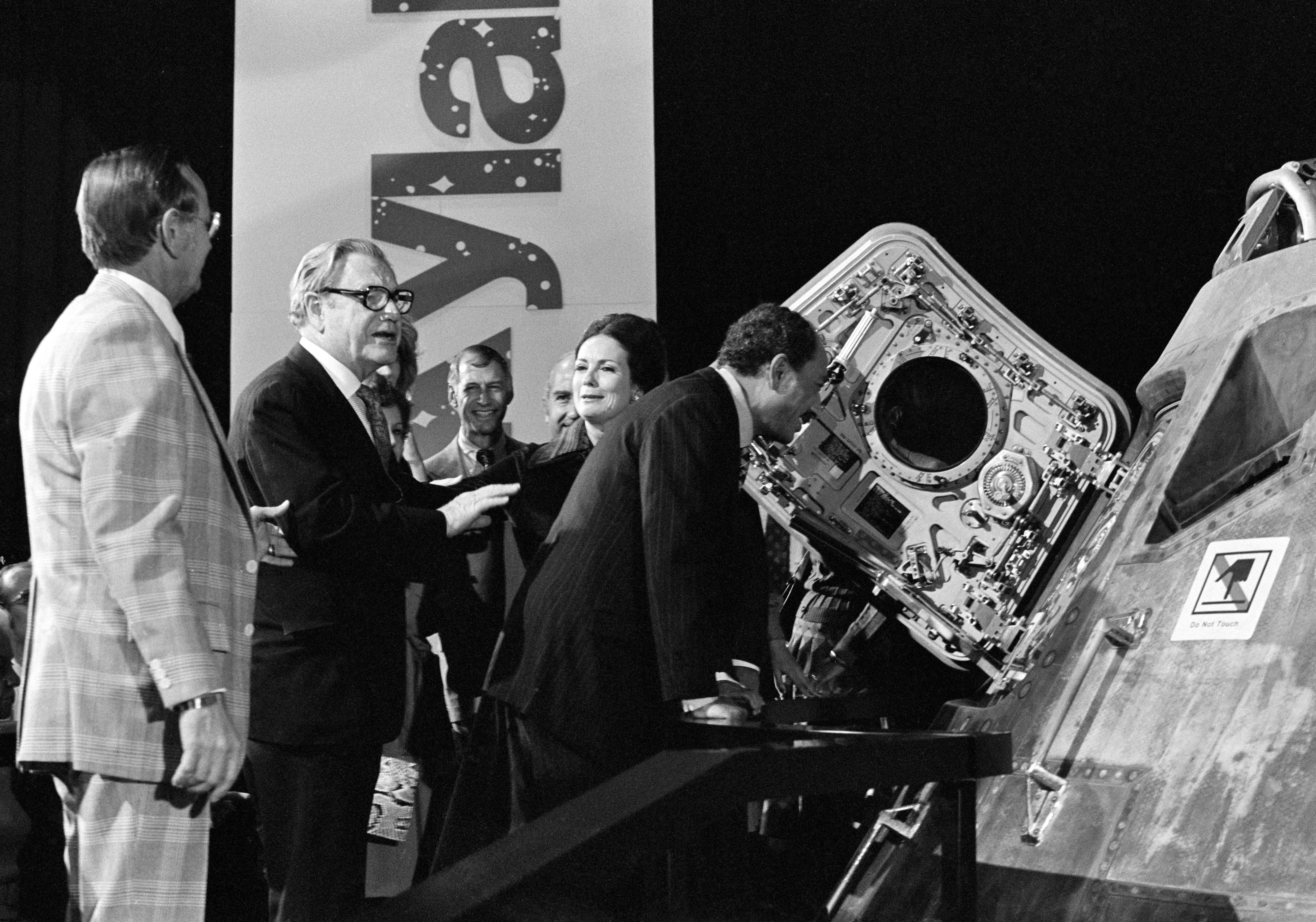
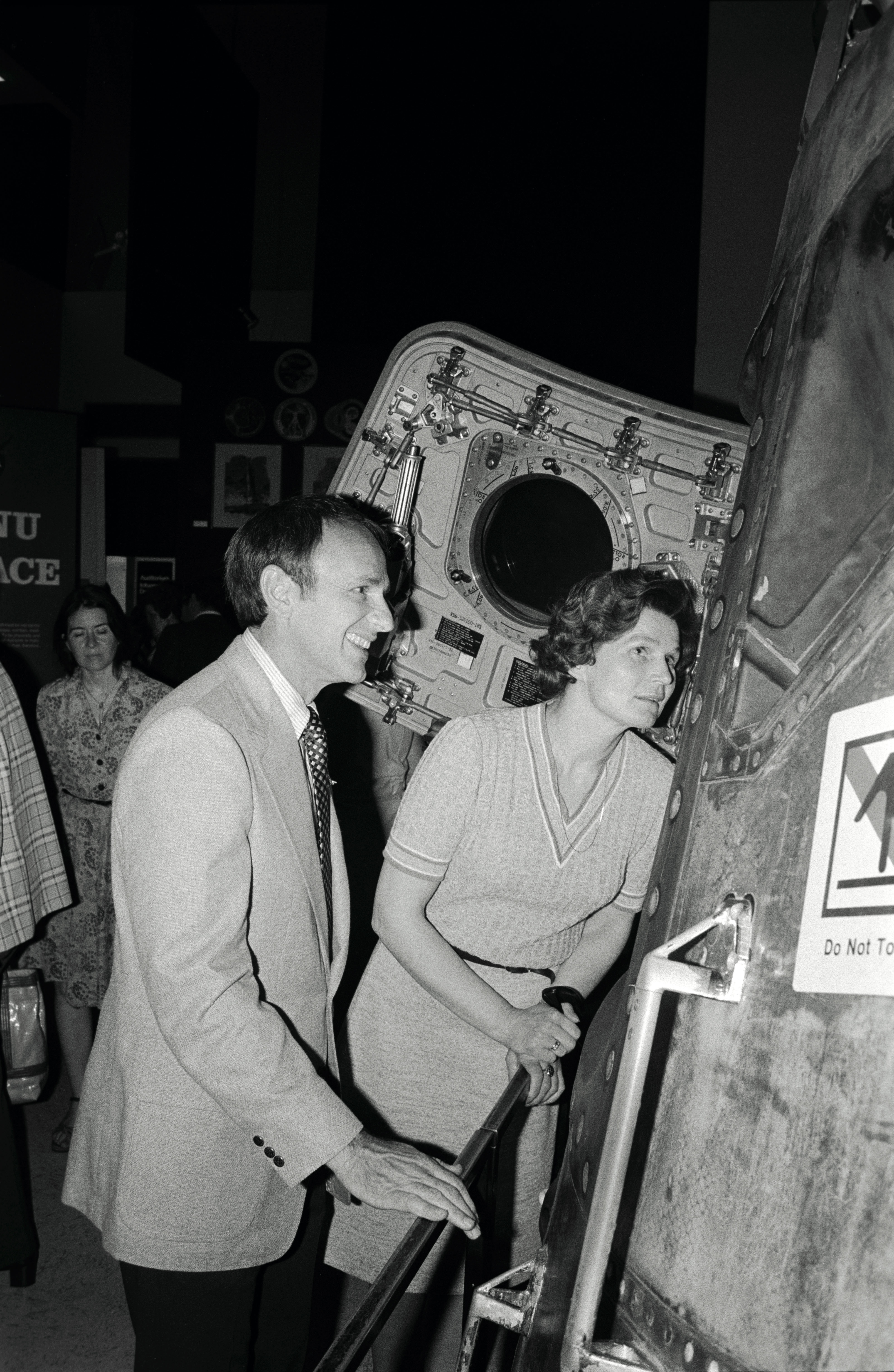
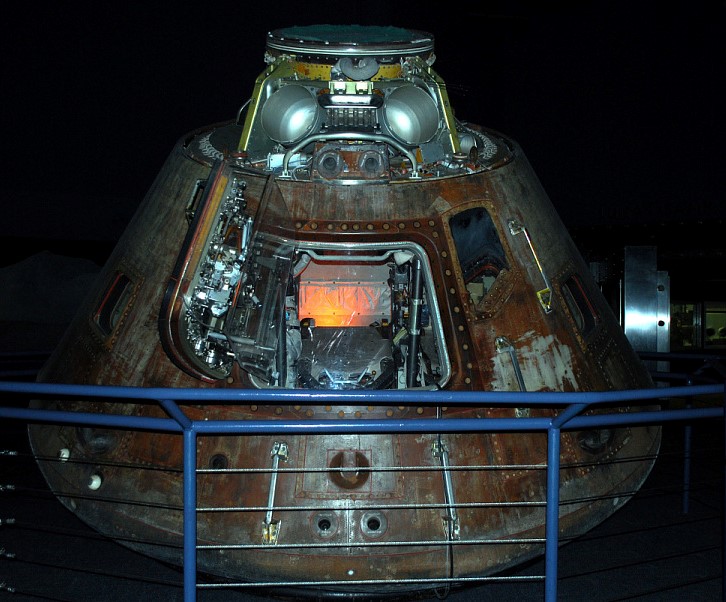
Left: President of Egypt Anwar el-Sadat, right, peers into the Apollo 17 Command Module (CM) America in the lobby of Building 2 during his official visit to NASA’s Johnson Space Center in Houston in 1975. Middle: Apollo 12 and Skylab 3 astronaut Alan L. Bean describes the CM America to Soviet cosmonaut and first woman in space Valentina V. Tereshkova in 1977. Right: The CM America on display at Space Center Houston.
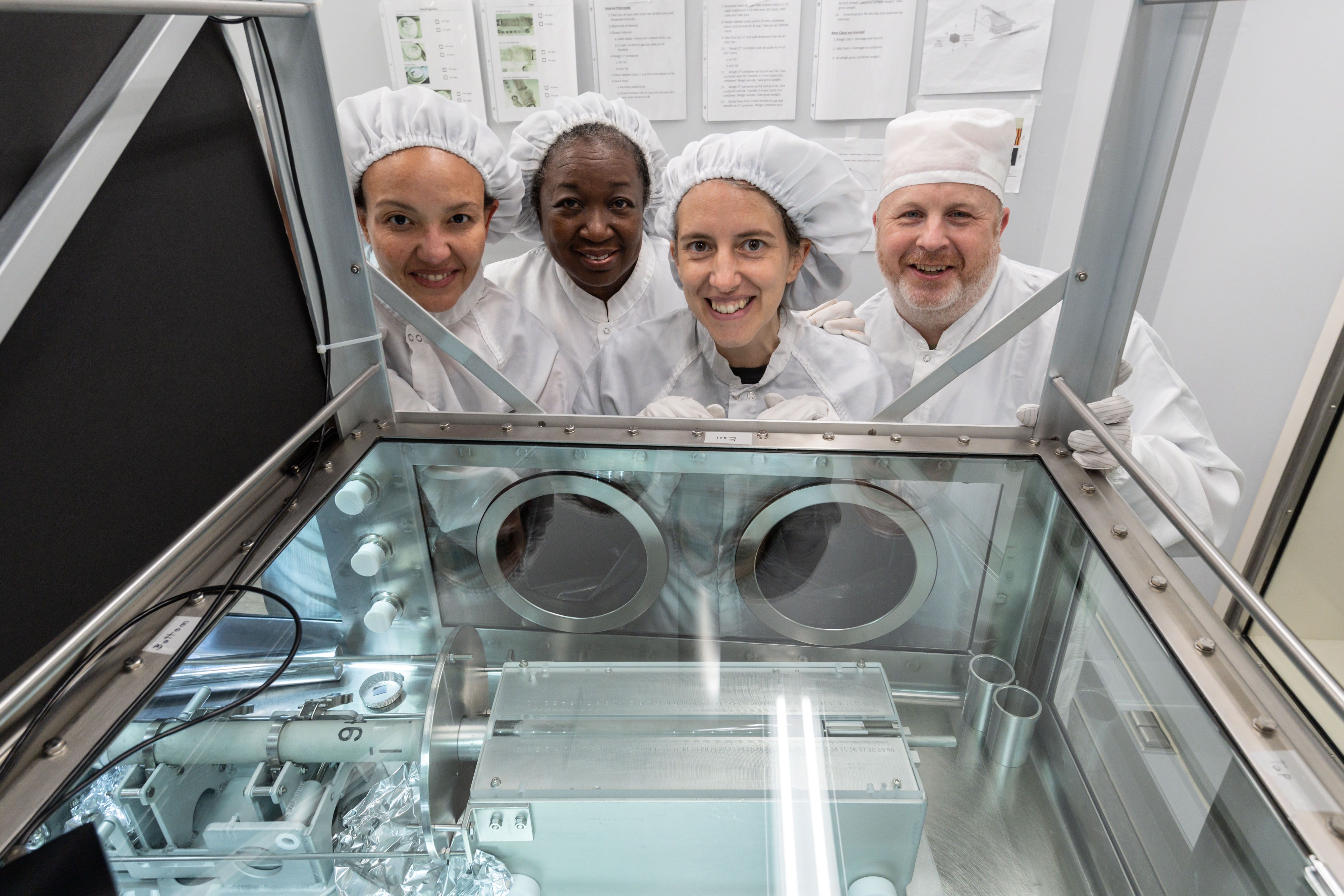
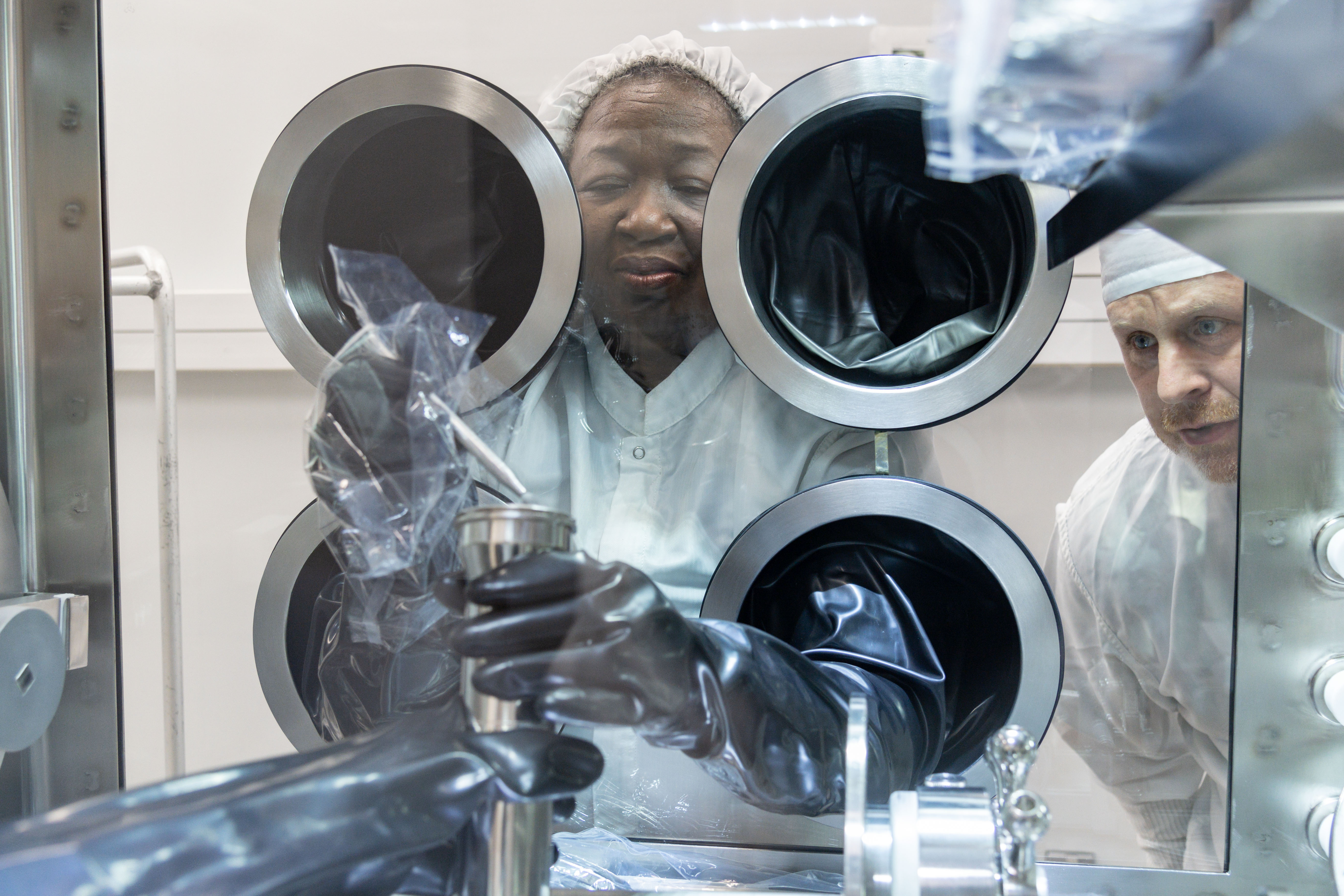
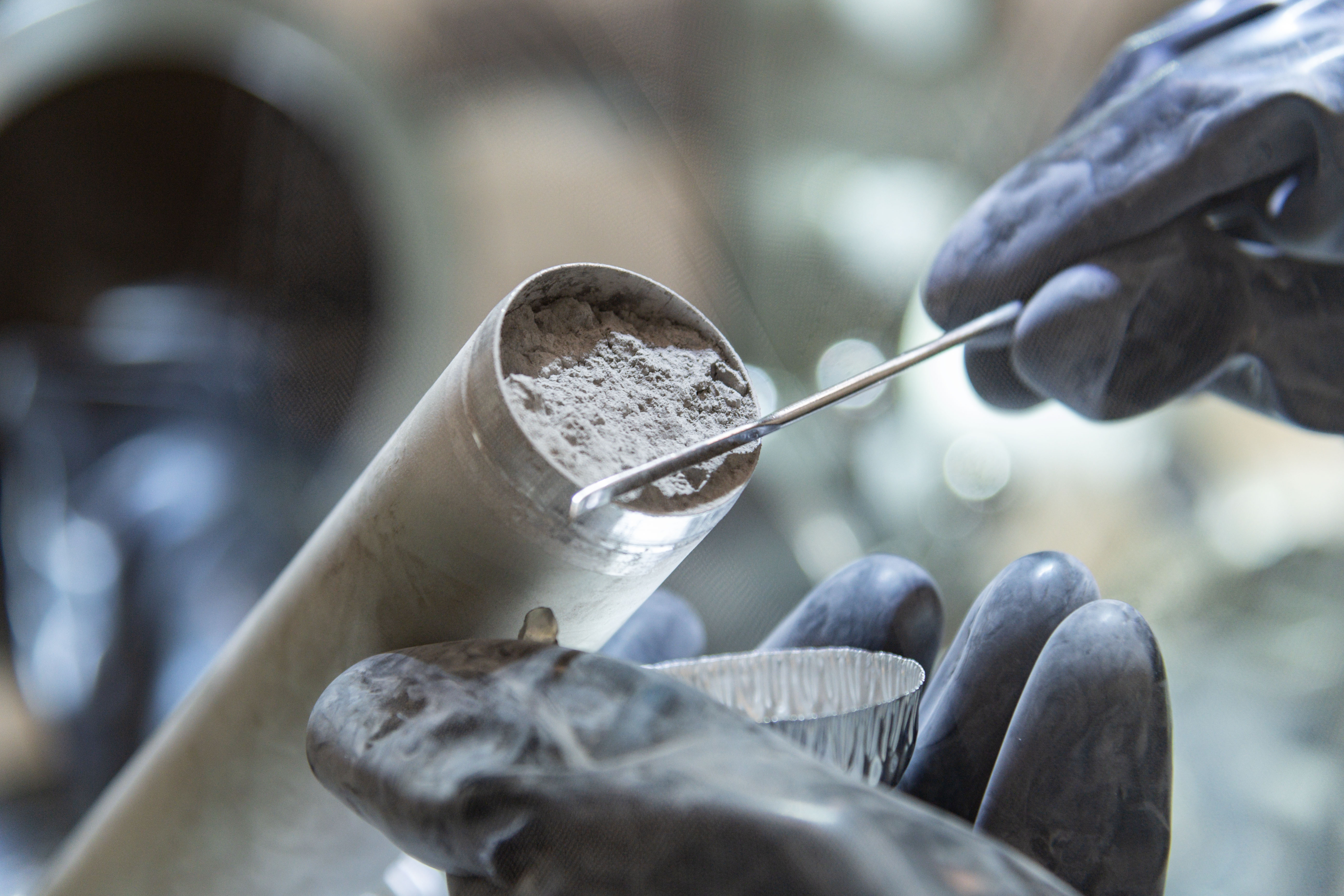
Left: The Apollo 17 core sample processing team of Charis Krysher, left, Andrea Mosie, Juliane Gross, and Ryan Zeigler in front of the newly opened sample at NASA’s Johnson Space Center in Houston. Middle: Working in a glovebox, Mosie extracts the core sample as Zeigler looks on. Right: Apollo 17 core sample 73001.8
The lunar samples returned by Apollo 17 still serve to teach scientists about the Moon’s history. In March 2022, nearly 50 years after the Apollo 17 astronauts returned them from the Moon, curators in JSC’s Astromaterials Research and Exploration Sciences Division opened one of the last sealed lunar samples from that mission. Cernan and Schmitt collected the core sample at Station 3 during their second excursion at the Taurus-Littrow site, where they vacuum sealed it. Curators had maintained the sample under vacuum since then, keeping it in pristine condition. The Apollo Next Generation Sample Analysis (ANGSA) Program seeks to analyze preserved samples from the Apollo program using technologies not available 50 years ago. Doing so will not only add to our knowledge of the Moon’s origins but also aid in the study of lunar material expected to be returned from the Moon’s South Pole during the Artemis Program to return astronauts to the lunar surface.
With special thanks to Ed Hengeveld for expert help with this article.
John Uri
NASA Johnson Space Center


























